#remembering kings and queens of early modern England and France
Explore tagged Tumblr posts
Text
Hi! Does anyone here have institution access and if so, access to Remembering queens and kings of early modern England and France by Estelle Paranque? My university doesn’t have access online, and while they are acquiring a physical copy via interlibrary loan I’d prefer a pdf version
I honestly just would want the chapter on Marie Antoinette. If anyone can acquire it on pdf and send it to me I’d be your best friend!!
4 notes
·
View notes
Text
Many positive personality traits can be glimpsed through [Margaret of Anjou's] personal letters, often written to people of influence on behalf of her tenants. Not only do they demonstrate a capable woman in command of her own affairs but also a compassionate one, with a desire to help the less fortunate and a strong sense of interpersonal relationships. Her letter to Nicholas Straunge, which asked him to permit the forbidden marriage of his daughter Katherine, revealed a romantic side of Margaret that wished happiness for young lovers; while her letter to the Lord Chancellor requesting his favor toward a “late clerk and familiar servant of ours” showed a desire to help former servants in their future endeavors."
Imogene Dudley, "She Wolf of Feminist Heroine? Representations of Margaret of Anjou in Modern History and Literature", Remembering Kings and Queens of Early Modern England and France: Reputation, Reinterpretation, and Reincarnatio
She was a romantic!
#historicwomendaily#margaret of anjou#15th century#english history#granted what Margaret was doing was what you were supposed to as far as queenship/'good ladyship' was concerned#but it's still very sweet#queue#i really wish the letters and correspondences of other queens during this time survived to this extent#my post
52 notes
·
View notes
Text
Berengaria of Navarre: The Queen Who Stood in the Shadows of History
Berengaria of Navarre, born around 1165, is one of the lesser-known figures in European history, yet her life was intertwined with some of the most significant events of the medieval era. As the Queen consort of Richard the Lionheart, Berengaria’s story is one of political intrigue, royal duty, and personal resilience.

Early Life and Royal Lineage
Berengaria was born into the royal family of Navarre, a small but strategically important kingdom that straddled the border between modern-day Spain and France. She was the daughter of King Sancho VI of Navarre and Queen Sancha of Castile. Growing up in a world shaped by territorial disputes and alliances, Berengaria's early life was one of privilege and royal education. Her father, King Sancho, was a capable ruler, and Berengaria was groomed to play a vital role in the dynastic politics of medieval Europe.
Marriage to Richard the Lionheart
The most pivotal moment in Berengaria’s life came in 1191 when she married Richard I of England, better known as Richard the Lionheart. The marriage was arranged to strengthen ties between Navarre and England during the Third Crusade. Richard was one of the most renowned crusaders of the time, and his marriage to Berengaria was seen as an important political alliance.
However, the marriage itself was far from conventional. Berengaria did not travel with Richard to the Holy Land; instead, she stayed behind in Sicily, where they were wed. This meant that, despite being crowned Queen of England in 1191, Berengaria did not exercise much influence over the kingdom. Richard spent the majority of his reign away from England, first on Crusade and then as a prisoner of war after being captured on his way back in 1192. During this time, Berengaria’s role was largely symbolic, and she remained in the background while Richard's officials governed in his stead.
Life After Richard's Death
Richard’s sudden death in 1199 marked another turning point in Berengaria’s life. Despite their long separation, Berengaria was deeply affected by her husband's passing. She never remarried, and instead, she returned to her homeland of Navarre. There, she played a role in the political life of the kingdom, though she never returned to England.
Berengaria’s withdrawal from the English court in the aftermath of Richard’s death is significant. It reflects the limited political power she wielded during her marriage. Despite this, she remained a respected figure in Navarre, where she lived a relatively quiet life until her death around 1230.
Legacy
Though Berengaria's time as Queen of England was short-lived and largely ceremonial, her legacy remains noteworthy. She represents the often-overlooked role that women played in the medieval royal landscape. In an age when royal marriages were primarily tools for forming alliances, Berengaria's marriage to Richard, though strained by distance, was an important diplomatic move. Furthermore, her ability to carve out a space for herself within the royal circles of Navarre after Richard's death shows her strength and resilience.
Today, Berengaria of Navarre is remembered not just as the wife of Richard the Lionheart, but as a queen who navigated the complexities of her time with grace, even if her life and reign were not defined by political power. Her story is a testament to the often-hidden roles women played in shaping history, even when their influence seemed less direct.
#Berengaria of Navarre#robert the wayward prince#william the conqueror#king richard of england#richard the lionheart#queen matilda#civil war in england#king john#robert curthose history
0 notes
Photo









TUDOR WEEK DAY 4: FAVOURITE ROMANTIC RELATIONSHIP
MARY TUDOR, QUEEN OF FRANCE & CHARLES BRANDON, DUKE OF SUFFOLK
“On Candlemas Eve, 1st February 1514, Charles Brandon, Viscount Lisle, was formally invested as the Duke of Suffolk. The ceremony took place at Lambeth, and was conducted by the king. Brandon was thirty, still handsome, one of the best jousters in all of England and possibly Europe, and a beloved friend of the king. He had climbed the social ladder at court to become a duke, the highest post anyone could hold. He was still nowhere near Mary’s station.” - La Reine Blanche, Mary Tudor A Life In Letters, by Sarah Bryson
“It is all too easy to romanticise Mary’s story: a beautiful princess forced to wed a much older man, tournaments where her English lover triumphs over his French rivals, a young widow defying her older brother - the king of England no less - to marry for love. For all its fantastic elements, the story is a true one” - The French Queen’s Letters: Mary Tudor Brandon and the Politics of Marriage in Sixteenth-Century Europe, by Erin Sadlack
“On March 3rd 1515, Mary Tudor married Charles Brandon, duke of Suffolk. Five hundred years later, their love match is still the most notable fact about Mary, and her and Charles’s narrative has become the quintessential Tudor love story.”
- Remembering Queens and Kings of Early Modern England and France: Reputation, Reinterpretation, and Reincarnation, by Estelle Paranque
38 notes
·
View notes
Text
XVII-XVIII Century Royal Queer History
Unexpectedly to myself, I got really engaged in history of Europe of XVI-XVII centuries. I never really had much interest in kings and queens and didn't know much about them but once I began to read and learn about their personal lives, I got kinda hooked. Also, I was struck by how many of them were queer and I began to write down my findings, which inevitably turned into a freaking study. I thought I might as well post it.
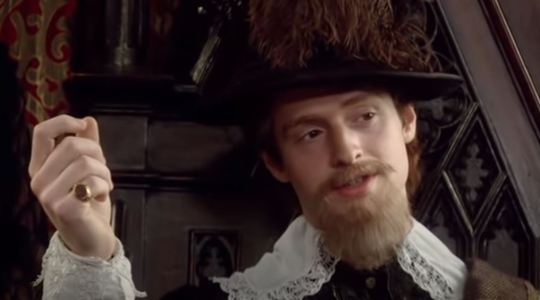
I'm gonna start with King James I of England who ruled in XVII century. Now there are several tumblr posts about this queer legend. Some historians think he was weak and unremarkable but he survived several assassination attempts, kept his power over 3 countries and lived to old age, which is pretty remarkable on its own. He also kept all the religious leaders at bay and commissioned the world's most famous Bible, which is still owned by most Christians 400 years later. He was also the one who created the modern wedding ritual. You know, church, vows, rings, that stuff. He avoided wars and was a patron of the arts, even wrote some books, including one about demons, werewolves and vampires. What a nerd. He was very different from Elizabeth who preceded him, so one contemporary epigram stated "Elizabeth was King, now James is Queen". Oh, also he was very gay. Or, at least, as gay as a king can get. His relationships with his male courtiers were notorious. He had several favourites who had way too much influence over him and his court really hated it.
He needs to have a movie made about him, seriously. I found only one semi-documentary film and it was The King James Bible: The Book That Changed The World (2011). While I liked the film and King James was hot, sassy and very cool, it was disappointing he was shown as perfectly straight. They could just avoid his personal life altogether, but instead they chose to show him being a perfect husband. While it is true that he was nice to his bride, by the time he met her he had a 10-year old relationship with a man 24 years his senior (since he was 14). I'm just gonna use this screenshot from the movie instead of a painting because it's too good.
Perhaps the most notorious of his alleged lovers was George Villiers, 1st Duke of Buckingham. Starting out as a son of a minor gentleman, the 21-year old lad caught the eye of King James I and quickly became his favourite teasing him by dancing in intricate performances called masques. He made a brilliant career becoming a knight, an earl, a Marquess, and finally a duke - a title normally being reserved for members of the royal family - within just 9 years. Can you blame him though? I mean, look at that stud.
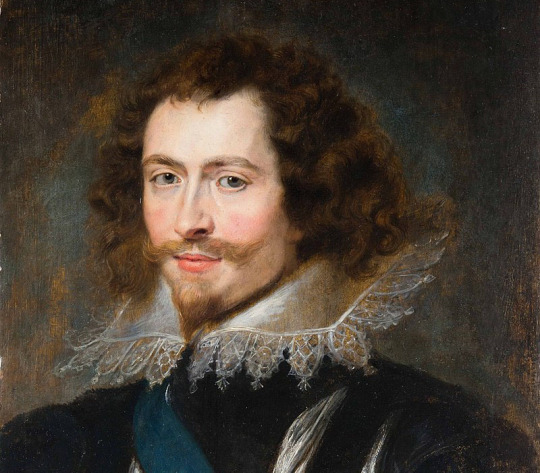
Btw, James’ pet name for Buckingham was ‘Steenie’, derived from St. Stephen who reportedly had the face of an angel.
The name Buckingham seemed oddly familiar to me but it took some time before I realized he was one of the characters in Dumas's "The Three Musketeers". Now I am someone who grew up on old pure Three Musketeers movies so when I started learning about the real historical figures involved in it it gave me a slight shock as the truth is way more weird and sinister that fiction.
The storyline I remember the most was the one where Anne of Austria, the queen of France, got in trouble with her husband Louis XIII because of her affair with Duke of Buckingham. Of course, Duke of Buckingham was never the Queen's lover, he was the King's. What's more, some historians assume Louis XIII was also queer. There is no evidence that Louis kept mistresses, but he had very intimate relationships with his favourites. He has even been described as “repelled by female contact”. There's also the issue of him struggling to have an heir. His wife had 4 pregnancies that were unsuccessful but that seemed like too few for a king who needed to secure his dynasty. After 23 years of trying, the king and queen were finally able to produce a son and another soon followed, the older son to become Louis XIV, and the younger, Philippe, to be known as Duke of Orleans.
Anne was quite the character for a dramatic story too. After Louis's death she became the Regent and made sure to clear the way for her son Louis. To ensure that Louis's younger brother will not try to usurp the power from him as it was with Louis XIII 's brother, Anne of Austria conducted an early and very wicked gender development experiment. She and her adviser, Cardinal Mazarin, set up a plan to raise the two boys very differently. Queen Anne called Philippe by such nicknames as "my little girl" and encouraged him to dress in feminine clothing, which he sometimes did even as an adult.

I'm just gonna use this quote because this shit is real: The queen and Mazarin discouraged the duc d'Anjou [Philippe] from traditional manly pursuits such as arms and politics, and encouraged him to wear dresses, makeup, and to enjoy feminine behaviour. His inclination toward homosexuality was not discouraged, with the hope of reducing any threat he may have posed to his older brother. Reportedly, Cardinal Mazarin even commanded his nephew, Philippe, to de-flower the king's younger brother.
Well, fuck. The joke's on them though, as Philippe grew up to be a fashion icon AND a fierce warrior. He participated in many battles and was immensely praised for his bravery and valour. In 1677, he led the French forces at the Battle of Cassel against William III of Orange of the Netherlands. Yes, that guy who later gently invaded England and took the throne. By the way, there are some allegations that he was also gay. Anyway, Philippe was so badass in battle that people glorified him as a hero and it made his stallion of a brother so jealous he sent him back and never allowed him on the battlefield again. Louis XIV continued his mother's effort in encouraging his brother's effeminate behaviour and putting up with his homosexual relationships, all the while waging a war of homosexuality in France. I mean, gotta preserve the traditional values, such as fucking 12 mistresses who were often married. There were even rumours Louis fucked Philippe's wife. I guess he was trying to make up for his father, brother, son, and uncle, César de Vendôme. Meanwhile, Philippe gave no fucks. He had a number of favourites and didn't even try to hide his sexuality. In fact, it is said that every time Louis pissed him off, Philippe did something extra gay and in his face. Fierce.
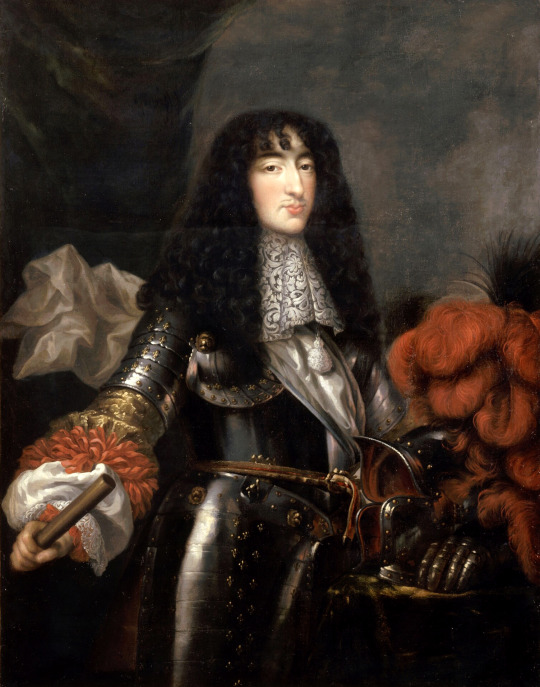
One guy I have to mention is Armand, the Comte de Guiche, who was said to be handsome, vain, and manipulative. Armand was Philippe’s lover, but he is widely thought to have been his wife Henrietta’s lover as well. That apparently wasn’t enough for the guy, because in 1665 he also tried to romance Louise de La Valliere, who was Louis’ chief mistress at the time. Louis exiled him in 1662 for plotting with Henrietta to break up Louis and Louise. What a glorious fucker.
But the love of Philippe's life was Chevalier de Lorraine who was basically a prince of a realm outside France. He's usually called 'Chevallier' but his name was also Philippe. He also had an older brother named Louis. Seriously, couldn't they try a little harder with the names? Anyway, when they met Philippe was 18 and Chevalier 15 and sparks flew. He was described as being “as beautiful as an angel” and was more than ready to use what his mama gave him. He was smart and very manipulative and Philippe showered him with gifts all his life, much to the chagrin of his two wives whose money and estates he often gave away.
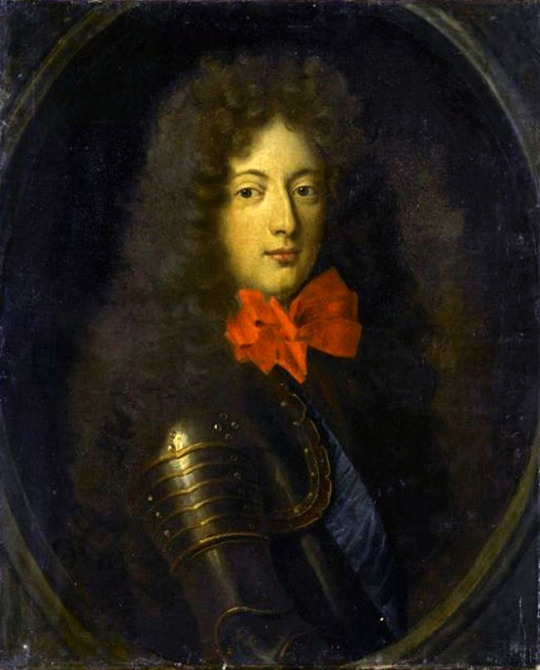
He moved to Palais-Royal, the same palace as Philippe and his wife Henriette. Very convenient. Philippe's marriage got kinda crowded. Chevalier got so arrogant, he actually told Philippe's wife she needs his permission to sleep with him and that he could get him to divorce her. She complained to the king and he got Chevalier imprisoned and exiled. However, not for long as Philippe pleaded the king to pardon him and eventually succeeded. Henriette did not get much relief apparently as she wrote: “I see from the ashes of Monsieur’s love for the Chevalier, as from the dragon’s teeth, a whole brood of fresh favourites are likely to spring up to vex me.” Of course, Chevalier also managed to enrich himself immensely by getting Philippe and the king to give him and his family tons of perks, such as make him the titular Abbot of four abbeys, which payed handsomely.
Henriette died very suddenly claiming she was poisoned. The doctors found no evidence of that, but there were still rumours that Chevalier was to blame. Philippe had to find another wife, even if he wasn't happy about it. Chevalier stuck around. He was exiled a second time after he apparently seduced the king's son (more on that later) but was able to return again. Their relationship lasted for 40 years, until Philippe's death.
There was a recent TV show called Versailles that depicts Louis XIV’s reign and it has a fairly accurate though romanticized portrayal of Philippe and Chevalier's relationship. Too bad the show is way too violent for me to watch. They look stunning in it~
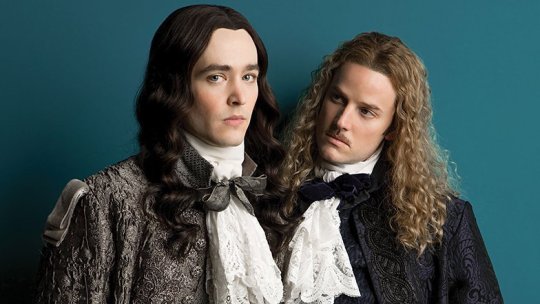
Anyway, such relationships were far from rare. In fact, apparently there were the so-called confréries (“fraternities”), which were basically gay brotherhoods whose members hung out together and set up orgies. One elite brotherhood was founded between 1680 and 1682. Apart from Chevalier, it included the king Louis XIV's cousin Prince of Conti who was once proclaimed the King of Poland, and Louis's illegitimate son, the comte de Vermandois. The latter was 15 in 1682 when at the court of his uncle Philippe, he met the Chevalier de Lorraine and his sect and apparently got very personally acquainted with Chevalier's younger brother and nephew. When the king learned about it, the group was forcibly dissolved and Vermandois was beaten before the king, exiled from court, and forced into marriage. Another such group was within the highest ranks of nobility at the court of Philippe II, Duke of Orléans, the son of Philippe and the regent at the time when Louis XV was young. They really didn't bother with names, huh? Anyway, they got involved in a number of scandals, in one of which that happened in 1722 a group of 17 noble men gathered in the palace gardens to fuck. The Regent didn't seem very bothered and even seemed to find it amusing.
The Regent, who did not stop smiling, was satisfied that it was necessary to give the nobles a harsh reprimand and tell them that they do not have the best taste [goût] in the world.
Dad would be proud.
There were also some (presumably) queer queens, like Queen Anne of England. Now you might have seen the movie The Favourite but it's heavily satirized and Anne wasn't really childlike and helpless. Actually, this image was created by Sarah Churchill, Duchess of Marlborough, after she was expelled by Anne, and stuck. However, the rivalry between the old and new favourites was very real.
Anne met Sarah when she was just 8. Sarah was beautiful, charming and very persuasive. When Anne became the queen, she made Sarah Churchill her Mistress of the Robes (the highest office in the royal court that could be held by a woman) and gave her a bunch of other really cool titles. She also made her husband, John Churchill, a duke. Thus Sarah became the most powerful person in England after the queen and the queen always listened to her advice. However, as years went by, Sarah became increasingly pushy and insensitive, using the queen to get what she wanted.
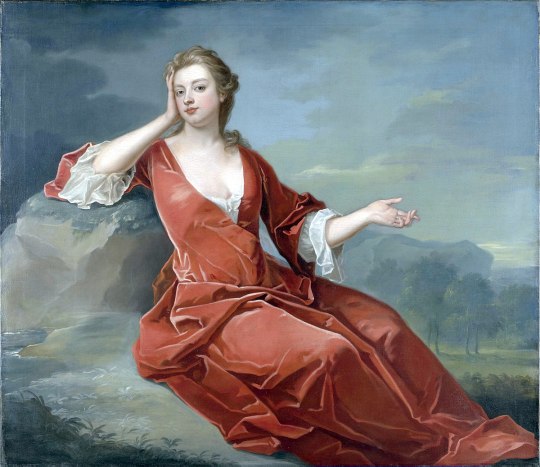
Sarah looking fab~
Then comes Abigail Masham, Sarah's impoverished cousin. Abigail was soft, caring and considerate, exactly what the queen needed. Sarah tried to get rid of her but it only angered the queen further and she eventually dismissed Sarah and her husband and banished them with disgrace while Abigale took her place. Sarah then wrote scandalous memoirs, painting the queen as weak and instable, as well as implying that her relationship with Abigail was lesbian. In mid-1708, she helped to circulate a ballad with such lyrics as: “Her secretary she was not / Because she could not write / But had the conduct and the care / Of some dark deeds at night.”
While there is no direct evidence that she and Anne had sexual relationship, there are many letters between the women that are very romantic and intimate. Sarah even used them to blackmail the queen. And you can kinda see why. “Tis impossible for you ever to believe how much I love you except you saw my heart,” the princess wrote in one letter, as quoted in Anne Somerset’s biography of Anne. “If I writ whole volumes I could never express how well I love you,” read another.
Also, like, evidence was hardly even a thing with queer relationships, since the only solid evidence of regular affairs were illegitimate children.
Finally, I really want to talk about Frederick II, the king of Prussia. Buckle up because this is gonna be long.
Until the age of 7 Frederick was growing up with his lit mother and sister. Here they are, looking gorge. I think he's in blue but tbh I'm not 100% sure.
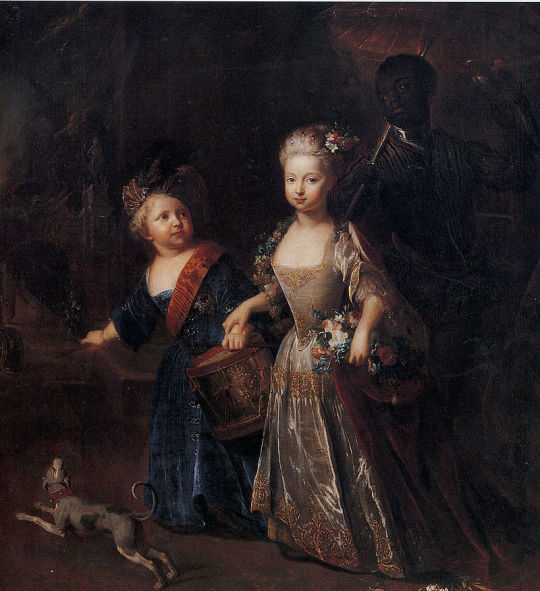
Anyway, as he got older he was taken to his father and that's when things got shitty. His father, Frederick William I, was the model image of toxic masculinity. He was all about power and military and expected his son to be the same. And since the boy was a lot more into music, poetry, and French stuff, his father often beat and humiliated him. He didn't allow him to learn French and Latin because, like, that's so gay. Now he was a real man. With a weird kink for tall guys. He is known for creating the Potsdam Giants, a regiment of very tall men that he didn't use for battle, just dressing them up and making them march. Ultimate straightness. It is probably redundant to say but his father also hated 'sodomy' and it was punishable by death, a law Frederick would repeal.
And the thing is, Frederick wasn't even supposed to become a king. He was the third son. It wasn't even disease. The first son died because a volley was fired close to his crib (because that’s the only way to wake up a real man - canon) and the second died at baptism because the royal crown crushed his skull. And you thought your parents were bad. Poor Frederick didn't even want to be a king, he just wanted to play the flute and do his thing. In a different age he'd be writing musicals on Broadway or something.
Anyway, there are few doubts among historians the man was gay. There's this BBC documentary that downplays it but it keeps saying he grew up in an environment where he was "leading a double life" and that he once wrote to a close friend that he felt he was a mirror that dared not be what nature made it, forced to oblige what was around it. Please.
Frederick's first presumed relationship was at 16, with Keith, the king's 17-year-old page. Unsurprisingly, Keith was soon sent to a far-off frontier. Right after that, however, Frederick got real close with an officer Hans Hermann von Katte. The dude was very woke and they both loved music and poetry but shit got very real very soon. In 1730, Katte and Frederick decided to flee to Britain to escape their despotic fathers. Sadly, they got caught and tried for treason. Although the prince was pardoned, Katte was sentenced to life imprisonment, which his sick dad changed to execution and then forced Frederick to watch it. At execution Katte and Fred shouted to each other endearments in French and before it happened, Frederick fainted. That shit really fucked him up and he got depressed but he toughened up and accepted his fate.
Aged about 20, Frederick was expected to marry. After a few failed attempts, an Austrian bride was selected, Elisabeth Christine of Brunswick-Bevern. Frederick was clearly unexcited and apparently even threatened suicide. As soon as he had secured throne, he sent her away and only met with her out of necessity. They had no children. And some historians are like, "well, they just didn't get along". Well, his folks hated each other but it didn't stop them from having 14 children.
Anyway, his father finally got off his back and as a crown prince, he mostly spent his time reading, composing, watching plays and writing woke political essays. Then his dad died so playtime was over.
Now that sounds like a story of a "weak" king. A man who loved to read books and play his flute. But it's not how it was. As Fred became king, he inherited a very militarized state with a huge-ass army and he worked with what he had. He started expanding Prussia, starting with Austria, which he had old beef with. He wasn't out for world conquest, he struck swiftly and strategically to consolidate and strengthen his state.
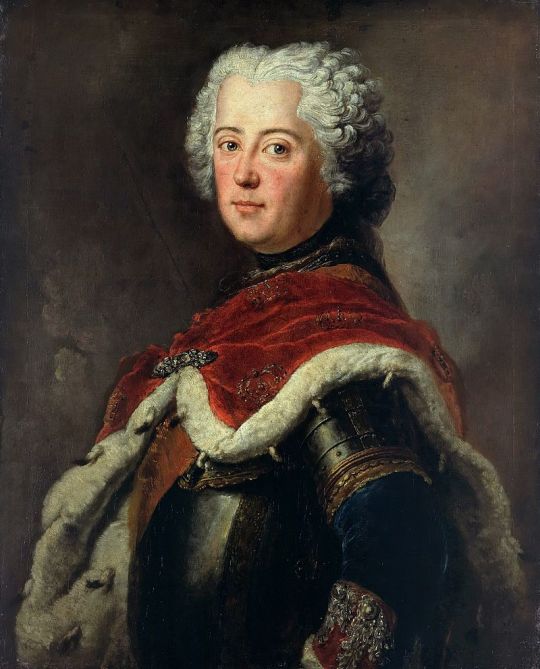
Frederick, widely known as Frederick the Great, waged war against much bigger armies with great success and doubled Prussia's size in his reign. Which is why Hitler was obsessed with the guy smh. Would make more sense if he was into the Frederick Senior, with his militarism and his little hobby of inbreeding giants and all. He must have missed the part where he was tolerant, modest and also gay.
Frederick also had a younger brother, Prince Henry, who was also gay. He was an important general in the king's army, though their relationship was quite complicated. Henry married but like his brother, bore no children, ignored his wife and spent time with fine lads.
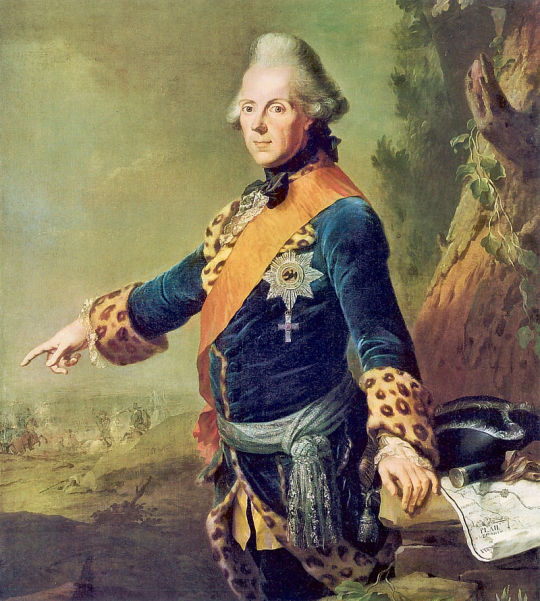
Look at this unapologetic legend!
When Frederick wasn't battling, he was doing lit stuff. He built a gorgeous palace in French fashion, full of Grecian sculptures and homoerotic paintings. He attracted the best intellectual minds of his time. Voltaire lived there for 3 years btw and he did not hold back to make many "wink wink" references to the king and his Grecian taste.
Speaking of which... One of his closest friends was Michael Gabriel Fredersdorf, an army private and a son of a peasant. Frederick met him as a prince and kept him by his side for the rest of his life, quite literally as he had an adjoined bedroom in his palace. He also made him a chancellor and gave him an estate, which really pissed off the elites.
Frederick is a complex character. Sure, he waged war and very successfully asserted himself as one of the top military leaders in history. But at the time Prussia was a scattered landlocked state, it couldn't just opt out of war so it's not like he could just go "peace out, bitches". But he did so much more. The guy actually believed that the king's duty was to be just and improve the lives of his people. He did some major reforms, improved education, supported art, and practiced religious tolerance, which was pretty woke at the time. He abolished torture and corporal punishment. He made governing more democratic by hiring people based on ability, not just status. Sadly, his cool legacy was utterly destroyed because the Nazi decided to appropriate him as their idol but lately it’s being reassessed. It’s hard to judge him considering how much he went through. But despite it all he became one of the best military commanders in history, one of the most woke and talented monarchs, and of course a legendary queer!
Disclaimer: I know all of these people did some terrible shit, at least by modern standards, but I'm here to have fun so I'm not going to go there now. Sources: medium.com/@LukeBoneham/the-politics-of-desire-... thehistoryofparliament.wordpress.com/2019/02/21... www.ranker.com/list/life-of-philippe-dorleans/m... cour-de-france.fr/vie-quotidienne/sociabilite-e... aelarsen.wordpress.com/2018/07/20/versailles-th... thedrummersrevenge.wordpress.com/2007/06/22/ref... dirtysexyhistory.com/2017/09/03/a-secret-gay-br... unspeakablevice.tumblr.com/post/82525976110/lou... journals.openedition.org/crcv/14427#ftn161 Marie Antoinette's World: Intrigue, Infidelity, and Adultery in Versailles The Real Versailles - BBC Two
BBC Four - Frederick the Great and the Enigma of Prussia https://medium.com/war-is-boring/historys-greatest-gay-general-fd7d1d311464 https://www.queerportraits.com/bio/frederick https://www.spectator.com.au/2015/10/frederick-the-great-king-of-prussia-is-a-great-read/ http://gayinfluence.blogspot.com/2011/10/frederick-great-1712-1786.html https://www.history.com/news/true-story-queen-anne-sarah-abigail-the-favourite-fact-check
#King James I#Duke of Buckingham#George Villiers#Philippe Duke of Orleans#Queer History#Chevalier de Lorraine#Queen Anne of England#Frederick the Great
104 notes
·
View notes
Text
DAY 4547
Jalsa, Mumbai Aug 14, 2020 Fri 10:34 PM
Birthday Ef - Kishore Bhatt (UK) .. Friday, August 14 .. BELATED BIRTHDAY GREETINGS TO YOU .. 🌹🌹 .. and apologies for missing out .. in these times of CoViD , the mind does not function too well .. love from all the EF ❤️❤️❤️
Birthday - EF Nitish Murthy .. Saturday .. August 15 .. may this day be ever remembered , may you have all the independence for a happy future ever .. from the Ef .. ❤️🌹🇮🇳
15th August .. Independence Day .. and our hearts and minds give credence and love to the sacrifices made so we may achieve what we are today ..
Happy Independence Day ..



.. MJ Akbar writes an article on Independence and Freedom and I found it interesting to share a portion of it here ..
Between Independence and Freedom
An unsuspected, and hence uncorrected, fallacy has caused much confusion in political philology, impairing analysis and understanding of the modern nation state.
Independence is not synonymous with freedom.
Both are essential to the contemporary ideal. They are compatible and often complementary. But the two virtues follow different trajectories and attain separate objectives. Independence is liberation from foreign or colonial rule; freedom is a right of every individual citizen which may be denied as easily by an indigenous ruling elite as by any foreign power.
India and America celebrate their independence on 15 August and 4 July respectively to commemorate the triumphant moment when they threw the British out of their lives. England has no such day since the English claim that they have never been ruled by a foreign power. Perhaps that was so long ago that amnesia is forgivable. The Romans invaded England in 43 AD and left only in 410 AD, when troops were summoned back to Italy, then being ravaged by “barbarians”.
The only memorable, and near-successful, British challenge to Roman might occurred early. In 60 and 61 AD, the queen of the Celtic Iceni, Boadecia, known in her native Welsh as Buddug, defeated Roman armies in battle and burnt down the colonizer’s capital, Londonium, forcing Nero, the emperor, to consider retreat. But his general, Seutonius, regrouped and won the war. Buddug, only 31, poisoned herself. Her pragmatic husband, Prasutagas, ruled as an ally of the Romans and left his kingdom to the Romans in his will. Colonial behavior has some interesting antecedents.
However, the British do retain a soft spot for Boadicea. She is not honoured on the holiday calendar, but her memory is preserved in a heroic statue at London’s Westminster Bridge and in a romantic luxury perfume misnamed Boadicea the Victorious.
The Norman conquest of Britain in 1066 was more nuanced, for the triumphant Frenchmen from Normandy soon blurred the difference between dependence and independence. The new conquerors did not rule England from France; they ruled swathes of their native land from England. Normans became the new English establishment. In a delicious paradox, French history books now venerate St Joan of Arc for liberating France from Norman royalty.
There is no confusion, however, in England’s history of freedom. It is legitimately traced back to the Magna Carta Libertatum, signed by a reluctant King John in 1215 to obtain support of the landed nobility against a French invasion. The charter gave barons the right of consultation on raising taxes through a council; this evolved into a foundational institution of freedom, Parliament.
From the late 18th century Britain and France began to devote more energy on conquering Africa and Asia than destroying each other, creating two formidable empires. Britain became the dominant power because India glistened as the jewel in its crown.
.. dear friend that spent anxious days when I was in hospital sends pictures of paintings that evoke my own visuals in the hospital :



.. the paintings are by Bowness Hepworth, who apparently had wished to be in the OT, where her child was undergoing a surgery .. she was permitted and these are the visuals she sketched .. so beautiful , artistic and have a certain reality grace in the lines and the use of colours ..
.. these have been the true warriors during this pandemic .. they work round the clock .. do not go back to their homes .. stay on the premises to attend to the patients , giving them treatment yes, but hope too and a gentle presence in the absence of loved ones .. salutations ..
.. the Genesis of the day is the solitude strains of the chords at play .. by yourself , by the rhythm , by the soul and heart of that which touches each bristling pore of the body .. there are attempts, gentle though , to regain the strength of the original .. a step at a time .. to reach to comply to look at the mirror with strength and will .. there is effort ..
.. slowly but surely ..

Amitabh Bachchan
146 notes
·
View notes
Text
The Forces of Nature || Ch.4
Pairing: Peter Parker x Superhero!Reader
Summary: “There’s this kid out there that can control the wind or something. I think she’s a great addition to the team. Let’s recruit her.”
SERIES MASTERLIST || PP MASTERLIST
Click the pictures for better quality and I still can’t believe I actually did this chapter with maximum effort lmao bc I actually studied so yeah have fun learning

Today was the day of Y/N and Peter's presentation about Queen Elizabeth I and Y/N wasn't nervous at all. She was confident about their presentation. Plus, their slide designs looked really cute and refreshing to look at. Y/N's outfit that day was a modernized version of a dress from the Elizabethan era. She designed it herself and she was proud of the outcome and that she got it done in time. Eunice helped, of course.
The sleeves were short and slightly puffed. The skirt went until her knees and it had layers underneath to make it puffy as well. The body of her dress was tight fitted because of the corset. The dress had a boat neckline and her only accessory was a pastel choker. In fact, her whole dress was pastel colored and her hair was styled in loose curls.
When Peter entered the room, Y/N was reading her book in her seat. Peter sat next to her and sensing his presence, Y/N turned to him and smiled, "Good morning, Peter."
"G'morning, Y/N." Peter gave her a tight-smile as he set his bag down. Y/N continued reading and without looking up from her book, she said, "C'mon say something about my outfit. I feel like you have something to say about it. You always do."
"How did you know that?" Peter asked. Y/N looked at him and smiled, "I can tell. Just say it. No hard feelings."
Peter cleared his throat and took a good look at her. He didn't have anything insulting to say. However, he said, "You look like you came out of a Melanie Martinez music video."
"She was part of the inspiration for this design." Y/N chuckled. "She's amazing."
Peter didn't get to say anything because Mrs. Johnson walked in the room causing Y/N to place a bookmark on the page she was reading and putting it in her bag.
"Who will present today?" Mrs. Johnson asked. Peter and Y/N raised their hands and Mrs. Johnson smiled, "Ahh, the geniuses. I expect a great presentation. The floor is yours."
Y/N took the flash drive from her pocket and handed it to Peter which was a subtle way of telling him to set it up. Mrs. Johnson walked to the back of the classroom and sat on the chair where observers usually sit. Y/N patiently waited as Peter sets up the whole thing. When it was ready, Y/N mouthed a small 'thank you' to Peter who just smiled and nodded.
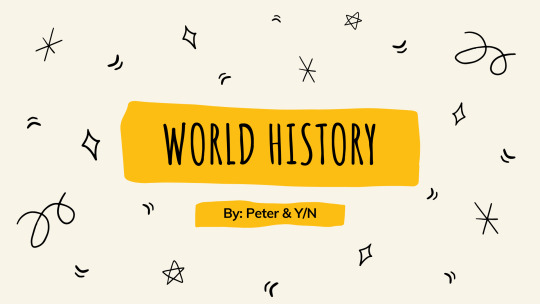

"Hi everyone! Peter and I will be talking about Queen Elizabeth I's early life until she became queen. We were told not to tackle her reign as queen because someone else will be presenting that." Y/N introduced and explained.
"Yes, please proceed." Mrs. Johnson smiled.
Peter clicked the next slide.
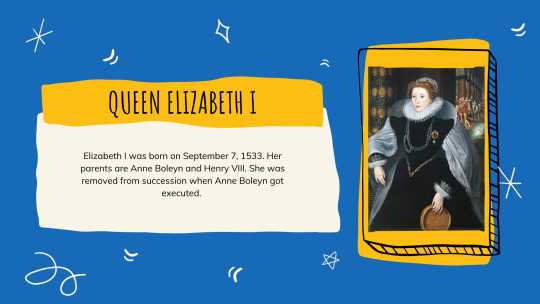
Peter cleared his throat and racked his brains for what he remembered. He and Y/N agreed that he'd explain the basic ones and would pipe in if he could remember some parts of her life.
"Queen Elizabeth I was born on September 7, 1533. She was the only child of King Henry VIII and Anne Boleyn. If you don't know who Anne Boleyn is, she's Henry's second wife and she got executed for treason." Peter said. "Anyway, since Anne Boleyn got executed before Elizabeth's third birthday, Elizabeth was left discarded and removed from succession of the throne."
"It was kind of complicated because Elizabeth and her sister, Mary, were due a certain level of care and they'd be in and out of favor depending on King Henry VIII's mood and marital status. I mean, what kind of father would do that?" Peter said with so many emotions. Y/N was in shock that he actually read everything, but she was also proud that he did so.
"Eventually, they realized that Elizabeth was a 'highly prized potential wife'." Peter said in air quotes. "I air quoted 'highly prized potential wife' because spoiler alert to those who don't know: SHE DIDN'T GET MARRIED. She's not called The Virgin Queen for nothing, guys."
"And because she was a 'highly prized potential wife', she was well educated and her education was first rate. She excelled in languages! She was intelligent, articulate, and open-minded. In short, she was ahead of her time. I mean, that's my opinion, of course." Peter said.
"Why do you think she was ahead of her time, Mr. Parker?" Mrs. Johnson asked.
"Because she was open-minded before anyone else. All of us have already evolved and we all keep evolving and growing as a society and yet there are people who are still so close-minded about things. If Elizabeth was open-minded since the 1530's, why aren't we all open-minded now?" Peter answered which made Y/N smile. It made Mrs. Johnson smile too and nodded for Peter to continue.
"And because she was well educated and stuff, she grew up quickly. It was great that she matured so fast but it suddenly didn't feel great when her brother, Edward VI, became King of England in 1547." Peter started. "Henry's widow, Catherine Parr, married soon after Henry's death. She married Thomas Seymour."
"It was reinstated under the terms of Henry's will that Elizabeth would be Edward VI's successor. She was under the care of Catherine Parr and living in her household. At the age of 14, Elizabeth first attracted male attention." Peter said.
"Not much is to be known about Thomas Seymour except for the fact that he was power hungry and in my opinion, a pedophile. I based that opinion from the fact that Thomas Seymour, in his late 30's might I add, engaged in appropriate behavior with Elizabeth. When Catherine discovered that, Thomas assured her that it was all innocent. One day, Catherine found Thomas and Elizabeth alone together in an embrace and because of that, Elizabeth was sent away in May 1548."
A classmate named Cindy raised her hand. Peter looked at her and said, "Yes?"
"Was Elizabeth okay after that?" Cindy asked. Peter grinned, "Good question."
"Yes, she was okay. Being sent away made it easy for her to move on from all of it, but only for a short time." Peter answered. "It was only a short time because when Catherine Parr died in... October, was it?" He looked at Y/N for help.
Y/N continued where Peter left off, "When Catherine Parr died in September 1548, Thomas Seymour tried to renew his relationship with Elizabeth. Of course, he failed. So, he manipulated Edward VI."
"Why did he do all those things?" Flash asked.
"Well, he was power hungry and he wanted to secure his authority that's why he did what he did. Thomas was arrested in 1549 for his inappropriate behavior towards Elizabeth and plots to overthrow his brother who was the Lord Protector of England. That same year, he was executed." Y/N shrugged as Flash nodded. Peter clicked the next slide.
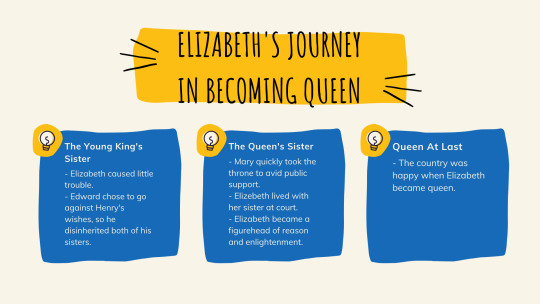
"Being Edward VI's sister, she caused little trouble compared to her sister, Mary, who went against the King's orders. When Edward VI fell ill in 1553, he went against Henry VIII's wishes and disinherited his sisters. Although his main issue was with Mary because of her very Catholic beliefs, disinheriting her would mean that he'd have to disinherit Elizabeth as well." Y/N reported.
"Well, that sucks." Flash commented.
"Indeed." Y/N said in agreement. "Anyway, when Edward died, Lady Jane Grey became queen... only for 9 days, though."
"A queen for 9 days? Why only 9 days? Did she die too?" Austin asked.
Y/N shook her head, "Nope."
"Who is she, anyway? She came out of nowhere!" Nadine exclaimed. "It's like she came there unannounced or something."
Y/N went to the board and grabbed a chalk and drew a chart of the Tudors for their classmates to understand. Peter stared at her in awe. "This girl knows her shit." Peter muttered under his breath as he crossed his arms out of habit.
Y/N turned to face everyone and started explaining, "Okay so let's start at the beginning. Henry VII and Elizabeth York are married and they had four children, namely: Arthur, Henry, Margaret, and Mary Tudor. Henry VIII and Jane Seymour had a son; Edward VI. Unfortunately, Jane Seymour died during childbirth."
"Anyway, Henry VIII's sister, Mary Tudor, married Charles Brandon the First Duke of Suffolk. They had a daughter, Frances Grey which makes her and Edward VI cousins. She married Henry Grey and they had a daughter who we all know as Jane Grey, the nine-day queen. In short, Jane Grey is Edward VI's niece." Y/N explained. "I hope that answers your question, Nadine."
"It did, thanks." Nadine said.
"I think it's weird that she's his niece." Allison mumbled.
"Now to answer Austin's question," Y/N said as she put down the chalk and rubbed her hands together to remove the chalk dust. Peter offered her a hand sanitizer which she gladly took and put some on her hands before giving it back to Peter and rubbing it on both of her hands.
"When Edward VI was dying, he disinherited both of his sisters and made Jane Grey his successor. So when he actually died in 1553, Jane Grey became queen. She was only queen for 9 days because the public basically didn't want her, they wanted Mary, Henry VIII's eldest and Edward VI's sister, to be queen instead. When Mary became queen, she wanted Jane Grey to be executed but she was spared upon the wish of the ones in the Holy Roman Empire. She was still a prisoner in the Tower, of course. Then she actually got executed when she refused to convert." Y/N explained. Austin nodded and took notes, "Thanks, Y/N."
"Okay so, now we all know that Mary became queen because the public wanted it. Elizabeth's life changed once again when her sister became queen and she now lived with her sister at court. Mary decided to reinstate the Catholic faith and of course it caused an uproar and such. Then this man named Thomas Wyatt started a revolt against Mary and it all just went downhill from there. In stark comparison to her irrational sister, Mary, Elizabeth became a figure of reason and enlightenment."
"Elizabeth was removed from the throne once more and after the rebellion was quashed, Elizabeth was interrogated because Mary suspected that Elizabeth took part in the said rebellion. There was no proof that Elizabeth had taken part in the rebellion, but she was taken to the Tower of London where she stayed for two months. In there, she was repeatedly interrogated and questioned. She never wavered from the protestations of her innocence and her love for her sister. Then Elizabeth left her prison for Woodstock and she was in house arrest there for nearly a year and the public was beginning to side with Elizabeth because Mary was getting crazy and out of hand. Elizabeth remained under house arrest until Mary came up with something to remove the threat."
"What was the threat?" Angelica asked.
"Elizabeth's ever-growing popularity was the threat." Y/N answered. "That's why she was sent to Woodstock."
"As Mary was thinking of a way to get rid of Elizabeth, she fell pregnant or she was already pregnant. If Mary had a healthy child, Elizabeth wouldn't become queen. But being pregnant is not easy so, this meant that Mary had to find Elizabeth a place for succession if she were to die in childbirth."
"She ended up not giving birth because her pregnancy was just a figment of her damaged imagination. In short, it was just a phantom pregnancy. Mary's health declined and she died on November 17, 1558."
"If Mary didn't bring her back in line for succession, how did Elizabeth become queen, then?" Brad questioned.
Y/N smiled, "Elizabeth became queen under the terms of Henry VIII's will. Now that she's queen, she already knew what to do and what not to do based from her family members. She learned from them and used it as stepping stones to be a great queen."

"Thank you for listening!" Peter and Y/N in sync. Mrs. Johnson and the rest of the class clapped for them. Peter took the flash drive and gave it to Y/N as they went back to their seats. Mrs. Johnson got up from her seat and went to the front of the class, "Thank you, Mr. Parker and Ms. Y/L/N. That was an astounding presentation! Both of you really did you research and I'm proud of both of you. You guys didn't disappoint."
Peter and Y/N smiled at each other and gave each other a high five. The bell rang signalling that class was over. The students put their things away as they prepared to leave the room.
"To the ones presenting tomorrow, my expectations are high!" Mrs. Johnson called out. "Bye class!"
Everyone left the classroom and Y/N left ahead with Peter running after her. "Hey, Y/N!" Peter shouted as he caught up with her. Y/N stopped walking and looked at him. Peter reached her and said, "Thanks for backing me up in there. I have to admit, we were amazing."
"Yeah, we were." Y/N smiled. "We make a great team, huh? I'll see you in the next class. I have to go to the library."
Peter nodded as he watched her walk away. What they did in class was great; they were great as a team. Perhaps it wasn't so bad to include her in the team after all.
After the last class, he went to the compound to report to the rest of the Avengers. When he arrived in the meeting room, everyone was already there and he was late.
"There you are, Peter! Sit." Tony said. Peter didn't hesitate to sit down at the only empty seat. Everyone looked at Peter expectantly.
"So, how's recruiting going?" Steve asked as he looked at Peter intently.
"It's alright. We did a report together and we were great. I have a feeling we'll get a high grade on it." Peter smiled.
"Does this mean that you finally agree to adding her to the team?" Scott asked with a giddy voice.
Peter shrugged, "It doesn't hurt to add one more person with powers, right?"
* * * *
:)))) I hope y'all are proud of my fucking research
𝐏𝐄𝐓𝐄𝐑 𝐏𝐀𝐑𝐊𝐄𝐑 𝐓𝐀𝐆𝐋𝐈𝐒𝐓: @myblueleatherbag @harryismysunflower @buckys-little-hoe @justanothermarvelmaniac @itstaskeen @sandystoriess
𝐆𝐄𝐍𝐄𝐑𝐀𝐋 𝐓𝐀𝐆𝐋𝐈𝐒𝐓: @marvelousell @justasmisunderstoodasloki @rubberducky-jrr @petersholland @osterfieldnholland @miraclesoflove @god-knows-what-am-i-doing @perspectiveparker @hollands-weasley @itstaskeen @call-me-baby-gir1 @the-panwitch @iamaunicorn4704 @chloecreatesfictions @holland-styles @halfblood-princess-505 @spidey-reids-2003
#peter parker#peter parker fanfiction#peter parker fanfic#peter parker fic#peter parker x reader#peter parker x y/n#in-a-lot-of-fandoms-tbh
60 notes
·
View notes
Text
CBC THE ROYAL FASCINATOR
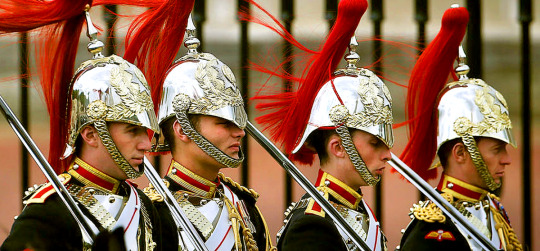
Friday, April 09, 2021
Hello, royal watchers and all those intrigued by what’s going on inside the House of Windsor. This is your biweekly dose of royal news and analysis. Reading this online? Sign up here to get this delivered to your inbox.
Janet DavisonRoyal Expert
Prince Philip’s life of duty
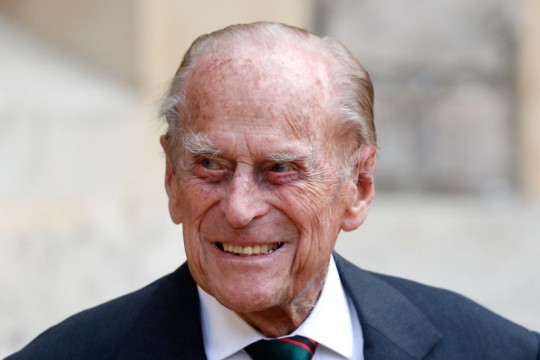
(Adrian Dennis/Getty Images)
For so many years, Prince Philip was at Queen Elizabeth’s side — or walking just behind — deeply devoted in his duty as consort to the woman who is now the longest-reigning monarch in British history.
But the Duke of Edinburgh, who died this morning aged 99 at Windsor Castle, was seen by many as having his own role in helping an institution steeped in tradition try to find its way toward the future.
Much of that began nearly 70 years ago, after the former sailor who gave up a successful naval career saw his wife ascend the throne.
“What Prince Philip did was help modernize the monarchy in the 1950s,” Michael Jackson, president of the Institute for the Study of the Crown in Canada, said in an interview this morning.
“It was still a very tradition-bound institution…. We can credit Prince Philip, with the Queen’s full support, of course, with modernizing [its] finances, protocols, how Buckingham Palace was run … its outreach to the Commonwealth.”
Philip pushed to have Elizabeth’s coronation televised in 1953, an idea she did not wholeheartedly welcome at first.
“He was the modern person,” John Fraser, author of The Secret of the Crown: Canada’s Affair with Royalty, said in an interview this morning. “He was in touch with real people, non-royal people, and so he always had the instinct to reach out. He understood both the dark side of the media presence as well as the necessity of it.”
Fraser credits Philip’s profoundly unsettled early years, after he was “born in poverty and insecurity,” with how he looked toward the future of the Royal Family, and the monarchy.
“I do think those early years were the single biggest factor in his life and how he approached life,” said Fraser. “I think he never assumed things would last forever because he didn’t make any assumptions like that, and I think he certainly assumed the monarchy wouldn’t survive if it didn’t reach out more to the constituency that it had to serve.”
Fraser met Philip, and recalled him as a man who would revel in asking questions and challenging others.
“He was — charming is not the word I would use — but he was an invigorating person to speak to.”
Jackson, who was Saskatchewan’s chief of protocol from 1980 until 2005, met Philip during four visits to the province — three with the Queen and one on his own — and remembered a man with “a great sense of humour.”
“Sometimes people found him a bit abrasive, a bit abrupt, but that’s the way he was,” said Jackson.
“He was a straight shooter and he complemented the Queen beautifully because the Queen is a very soft-spoken, more laid-back person. Prince Philip really spoke his mind and occasionally made jokes and … put everyone at ease. I found him very refreshing, good to work with.”
With Philip’s death, there is an inevitable sadness for the Queen, and inevitable concern for how she will cope with the passing of her husband of more than 73 years.
Both Fraser and Jackson say the Queen will carry on, with Jackson noting “That’s the way she is. She’s a very strong person” with a deep religious faith that will sustain her.
“She’ll do her duty,” said Fraser. “And I think that’s the big lesson of him. He did his duty.”
For a full obituary of Prince Philip, click here.
For photos from Prince Philip's royal career, click here.
Family dysfunction
When Philip Mountbatten married Princess Elizabeth in 1947, the family he was joining was in marked contrast to the fractured one he had known in his youth. His parents' marriage broke down and offered him nothing like the nuclear family arrangement (mom, dad and two kids) that Elizabeth had known throughout her childhood. "In marrying the Queen, [Philip] gained that sort of stable home life that he didn't have when he was younger," royal author and historian Carolyn Harris has said in an interview. Philip's parents were Prince Andrew of Greece and Princess Alice of Battenberg, a great-granddaughter of Queen Victoria. Philip was born a prince of both Greece and Denmark on June 10, 1921, on the dining room table at Mon Repos, a villa that was the summer home for the Greek royals on the island of Corfu. He was the last of five children — his four older siblings were all girls. At the time, he was sixth in line to the Greek throne. But life in Greece didn't last long. His father, a professional soldier, was exiled from Greece in 1922 as his uncle, King Constantine I, was forced to abdicate. Philip's family fled, with the story being that Philip was nestled into an orange box as the family was evacuated from Greece on a Royal Navy ship. They eventually made their way to Paris. Philip's childhood took a "dysfunctional turn," author Sally Bedell Smith wrote in her book, Elizabeth The Queen, when he was sent by his parents at the age of eight to England for boarding school. The family eventually broke down. Philip's mother, who was born deaf, was ill periodically, diagnosed with schizophrenia and spent time in a sanitarium in Switzerland. His father went off with his mistress to Monte Carlo, where he died in 1944. Philip was left to be brought up in the U.K. by his mother's family, shuffled among various relatives and boarding schools throughout his youth. He didn't see or have any word from his mother between the summer of 1932 and the spring of 1937. "It's simply what happened," Philip said matter-of-factly in an excerpt from a book by Philip Eade, Young Prince Philip, Turbulent Early Years, published in the Telegraph. "The family broke up. My mother was ill, my sisters were married, my father was in the south of France. I just had to get on with it. You do. One does." As life went on, there really was no father to guide, consult or do anything else a father can do for his child. Several other close relatives died in his early years, including his favourite sister, Cecile, and her family in a plane crash in 1937. The following year, the 2nd Marquess of Milford Haven, his uncle and guardian, died of bone cancer. That left the marquess's younger brother, Louis Mountbatten, to bring up Philip. His family ties also extended into Germany. Three of his sisters were married to German princes involved in the Nazi party. Cecile and her husband, Don, had just joined the Nazi party before they died. Those family alliances had a visible repercussion when Philip and Elizabeth were married in 1947. "His sisters were not invited to the wedding as they were married to German princes who had been involved in the Nazi party during World War Two," Harris said. Philip's mother, Princess Alice, however, was at the wedding, and in her later years, came to live at Buckingham Palace. Alice had her own moment in the cultural conscience in 2019, as an episode during the third season of the Netflix drama, The Crown, focused on her. "She's just the most extraordinary character," Crown creator Peter Morgan told Vanity Fair. She set up charities for Greek refugees and later established a nursing order of Greek Orthodox nuns. During the Second World War, while her son was serving with the Royal Navy and her German sons-in-law fought for the Nazis, she was hiding Jews in Athens. As much as there was the distance between Philip and his mother in his younger years, there was a closeness later. Alice came to live at Buckingham Palace in 1967. Alice died at the palace in 1969 and was interred in the royal crypt at Windsor Castle. In 1988, her remains were transferred, as she had wished, to the church of St. Mary Magdalene in east Jerusalem. In a 1994 visit to the Yad Vashem Holocaust memorial in Jerusalem, Philip planted a tree in his mother's honour and visited her gravesite. "I suspect that it never occurred to her that her action was in any way special," Philip said during his visit. "She was a person with deep religious faith and she would have considered it to be a totally human action to fellow human beings in distress."
No stranger to Canada
(Frank Gunn/The Canadian Press)
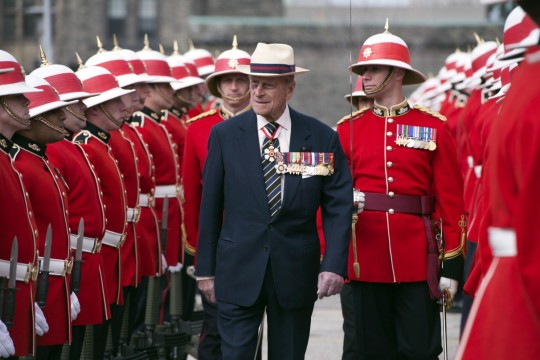
Prince Philip's last visit to Canada was a short one in 2013 — on his own, without the Queen — to present a ceremonial flag to the Royal Canadian Regiment's 3rd Battalion. It came as something of a surprise. Philip had experienced a few health scares in the 18 months prior. So overseas travel was not necessarily a given for the Duke of Edinburgh at the time. But given Philip's feisty personality, dedication to his role and some of the interests he showed over the years, his return to Canada — he made more than 70 visits or stopovers between 1950 and 2013 — may not really have been a complete surprise. The 2013 trip was billed as a private working visit and was only a few days long. But while he was here, he was finally able to pick up the insignias he had been awarded as companion of the Order of Canada and commander of the Order of Military Merit from David Johnston, then Canada's governor general.
To read more about Philip’s time in Canada, click here.
Royally quotable
“He is someone who doesn't take easily to compliments but he has, quite simply, been my strength and stay all these years, and I, and his whole family, and this and many other countries, owe him a debt greater than he would ever claim, or we shall ever know.”
— Queen Elizabeth, publicly acknowledging Prince Philip’s importance to her during a speech on the occasion of their 50th wedding anniversary in 1997.
To read more on what Philip meant to the Queen, click here.
Remembering Prince Philip
Royal Fascinator readers are welcome to share their thoughts on the passing of Prince Philip, and any memories they may have of meeting him over the years. We’ll include some in the next edition of the newsletter.
I’m always happy to hear from you. Send your ideas, comments, feedback and notes to
. Problems with the newsletter? Please let me know about any typos, errors or glitches.
GSTQAOBC 🇨🇦🇬🇧🇦🇺🇳🇿
7 notes
·
View notes
Text
Chapter 1. The Case Against Fairytales
'his eyes across a room tangled up in her imagination they had spent a lifetime together by the time he said hello' atticus
My brother died the same way he came into the world: silent, eyes closed, changing my life as I knew it.
We spent our whole lives trying to convince anyone we could that we were as regular as they were, but here's the first fundamentally different thing when you are royal: the meaning of the word ‘everyone’.
In our case, we usually mean anyone in the country, most of the international media, and at least a sizeable majority of the world's population. It's not that everyone knew us... it's just that enough people did. Enough for it to be easier to call them 'everyone'.
When my brother Louis was born, mom had been rushed to the hospital in the middle of a Sunday afternoon. The press was notified, they promptly set up camp at the hospital entrance, and the people started prayer campaigns to the safe arrival of their new prince and heir. Everyone rejoiced at his arrival. I remember, I was there.
At three years-old, it felt like everyone was every single person in the planet. It was mostly just the people in our country; to everyone else, his birth was a quick, short line of announcement, maybe some notice to the fact that the newborn baby boy was taking his older sister's place as heir, and not much else.
When he died, everyone was every single person in the planet. The second thing fundamentally different when you are a royal: from a very early age you must learn that tragedy sells more than joy. And in any constitutional monarchy country, a royal family is merely another commodity.
A few people talked about my early graduation from University. A lot more people talked about my boyfriend breaking up with me. There were a few articles about my little sister's victory at the ice-skating junior final. When she fell on her face in front of the cameras while attempting a risky move, she went viral. When my brother came into our lives, a few people took notice.
When he left us, everyone did.
---- ---- ---- ----
I, too, am a victim of culture appropriation. Since the dawn of time, from the moment humankind developed communication skills, there has been storytelling. And for the past few thousands of years most stories that parents tell their young as they tuck them into their blankets every night, have been about my culture. As far as that goes, it is not the most damaging kind of culture appropriation. But I have a duty today, and I will not shy away from it. I am sorry to say I must, and will, shatter the beautiful image of fairytales that kids have been fed for so many years now.
I know what you are thinking – oh, boo-hoo, the poor little princess girl; is life too difficult in your beautiful palace with all the money a person could ever need? And yes, I know. I am not a victim. The same colonialism that placed my ancestors, and therefore, me, in the position of privilege and power I am in today has created many more actual victims around the world. But that is also why I must tell this story the way it was always meant to be told: truthfully. With all the weird, awkward, awful, bits and pieces that fairytales tend to skip.
Fairytales would, for instance, skip straight to the grand, majestic welcome ceremony between the Queen of the United Kingdom and the King of Savoy in a sun floored courtyard with guards on tall, furry black hats strutting around, standing in a red-carpeted dais, with a handsome prince making eyes at me. But in my story, we will start with the train.
That’s right, in modern fairytales you don’t take a lovely carriage ride to a neighboring kingdom. You take a train there – a commercial train, if you can, because modern times beg for demonstrating to the masses that the Monarch isn’t throwing money around. We were trying to highlight the easy routes of access to our neighbors to the northeast, and so we took the ferry across the Celtic Sea to Hugh Town Island and from there, Eurostar number 2 train that made a quick stop in Penzance, UK, and then went straight to London.
The train ride isn’t comfortable – even if you have a first class private car. It’s bumpy and crowded and a terrible place to spend three straight hours. On that particular morning, I was in our car with my father, his household secretary Auguste, my private aide, Cadie, and a few other staff members.
In fairytale world, when a princess does not look the part, there is usually the appearance of a fairy godmother who sings a nice song and magically transforms her into a Proper Princess™. There is no fairy godmothers when you are a real princess- real ones, sure, but they are not magical-, but you do learn from an early age what a Proper Princess™ should look like, act like, and sound like, and god forbid you don't.
In the train that day, I heard all that was keeping me from being Proper™ from Auguste, who was in many ways the exact opposite of a fairy godmother. He had all the menacing authority of one, with none of the charm. He also didn’t have wings or a sparkly wand; he had greying short hair, and thin, small, reading glasses that he always pushed down to the tip of his nose to look above, which made me wonder what was the point of the glasses at all.
Before our arrival, I had to change my lipstick, which was too dark, my dress, which was too short at the daring height of above my knees, my shoes, which were open toed and therefore wrong, and finally, make sure to brush my hair once more.
My parents never subscribed to the idea that we were forbidden to do anything. They were raised on stern rules and heavily traditional costumes and wanted their kids to live more freely. So, growing up, they revolutionarily told us that we were free to be whoever we wanted to be – in private. In public, we had an obligation to be Proper™. After all, as I heard repeatedly growing up: royals don’t make mistakes, we make history; and history remembers.
So, yes. I, a grown, 25 years-old, law-school graduate, bar-approved acquisitions lawyer, changed out of my dress into a more proper one because my dad asked. Because as a princess, you’re never just yourself; you’re the country. And if your country comes from a Roman Catholic tradition, your hemlines must reflect that, no matter what century it is.
The country in question was just to the south of the United Kingdom, west of France, a large island named Savoie. The English call it Savoy, which is how it was pronounced anyway. It was originally populated by the Irish, but over the years it was conquered by the English, the Spanish, and the Portuguese until finally, in the 13th Century, it was conquered by France. It was bigger than Ireland, but smaller than England, and one of the biggest GDPs in the world, with a population of 49 million. Under the reign of Louis XV, however, France lost most of its possessions after its defeat in the Seven Years' War, and to secure Savoy, the king sent part of the court to live there and to reign in his stead as his emissaries. Louis XV's reign grew weak, including his ill-advised financial, political and military decisions, which discredited the monarchy and arguably led to the French Revolution 15 years after his death. France dealt with its dissatisfaction by revolting, Savoy however, secluded away at sea, decided to declare independence before the Revolution had even taken steam. The political leaders of the Island reached an agreement with the king's emissary, Prince Louis, the highest ranking monarch on the island; in exchange for support for the severance of all connection to France, he was then made King Louis I of Savoy. The Royal House of Savoy grew steady and strong by protecting its people and assuring them a freer, better life than the one they'd known under French reign.
A few years later, I sat on that train in front of the current King of Savoy. My father.
“You look beautiful, Maggie.”
“Thank you.”
“The other dress was beautiful as well. Just not for today.”
“Mm-hm.”
A moment of silence went by. I picked up my phone and checked my emails. There was one from Sophie with the subject ‘urgent!’ so I clicked in it feeling my heart race.
It read,
‘Marie, I’m sorry to bother you on your days off, but the depositions got moved up to Monday and we can’t find the notes on the manager deposition, you were the one who did them. Is there any chance you have a copy and if so can you send them to me? Enjoy England! XO Soph’
Sighing, I put down my phone and quickly found my laptop on my suitcase. I turned it on as I replied to Sophie’s email to tell her to expect my deposition notes shortly.
“You know if we could I’d let you wear whatever you wanted.” Dad added as I logged into my computer.
“I do.”
I moved quickly through my folders realizing the most recent update on my notes hadn’t been uploaded to the cloud. Sighing, I logged on to the train WiFi and checked the storage service online. It didn’t connect.
“Honestly, darling, you look even prettier with this dress.”
I looked up, mentally wondering if the previous versions of the notes would be useful.
“This isn’t about the dress.”
I realized, then, that it wouldn’t matter anyway because I wouldn’t be able to send them to Sophie without internet. I looked out the window, realizing perhaps too late that we were in the tunnel, underwater. Of course there wasn’t internet.
“Well, what is it about?” Dad asked, putting his book marker back inside the page he was on and laying down the book to give me his full attention.
“Work, papa. I have a job.”
“Yes, and it’s your day off. Maybe you should try and turn off from work for the next few days?”
I smiled down to my computer, “maybe this is a conversation for another time.”
Dad adjusted his posture, looking a little taller, and looked around the room to Cadie and Auguste sitting in a booth nearby with our private hair and make-up artist, and dad’s footman, and personal aide.
“Excuse me, everyone, would you be so kind as to give us the room? Or, uh, the car? There is a little lounge outside, isn’t there?”
“Of course, sir.” Auguste said, jumping up immediately with the aide, and Cadie and Cass, the make-up artist, followed.
After they had left and closed the door behind them, I looked at my father. He lurched back in his seat and smiled at me.
“Go on,” he said. “If you don’t scream I don’t think they’ll hear us.”
“Why would I scream?”
“I don’t know, Maggie. But I don’t know why you would be so passive aggressive, either. Can you tell me?”
“What do you want, dad?”
In truth, I added the ‘dad’ at the end of the sentence to make it sound less aggressive, but as he stared at me, I felt uncomfortable not explaining myself.
“I’m here, aren’t I?”, I asked, tiredly. “I’m here, wearing a proper, long, not-slutty dress-“
“No one here used that word-“
“My toes will be perfectly hidden away when we arrive, I have hidden my ugly, evil legs under some stockings-“
“Really, Maggie, no one said your legs were-“
“My make-up is light and my hair is simple and non-threatening. I know not to smile too much or too little and to let the adults lead the conversation”, I said, the word ‘adults’ dangling bitterly from me lips. “And not to walk ahead of you, but always behind, taking your lead.”
“You make it sound so stiff and calculated.”
“And I have taken time off of work to be here.” I said. “All other Junior Associates are working overtime and through weekends to cash in as many billable hours as possible to be promoted to Full-time Associates, and instead I took off four days to travel with my dad.”
“Work, for work!”
“So, again, what do you want? How else am I not meeting your expectations?”
I spoke calmly, gently, and as low a volume as I could just to confront his joke not a minute before about how if I didn’t scream the others wouldn’t hear us. I made sure to be as poised and contained as I could. He heaved a sigh.
“I’m sorry you had to take time off work.”
I waited, as he stared in his usual lovingly, patient way. I smiled, more as a peace offering than genuinely.
“You know very well they won’t fire you.”
Still, I was quiet, smiling as sincerely as I could.
“And I know that isn’t fair, but there’s nothing I can do about it. So tell me something I can do and I will.”
“Okay.” I said, nodding. “I want your honesty. Don’t treat me like a child you need to protect, don’t patronize me. All I want is an honest answer.”
He adjusted himself in his seat and cleared his throat. “Alright. Go on.”
“Why am I here, papa?”
He blinked, seemingly confused. I could tell he expected a harder question.
“Your- Because your mother sprained her ankle?” he answered, still unsure. “What- do you mean philosophically? Why are any of us here, really? I don’t understand.”
I tried not to smile. “I mean I have a life. I am not your heir. Louis is your heir, it is his job to help you when mom has emergencies.”
He sighed deeply, finally arriving at the same page where I was.
“Your brother is in school.” He said. “And you are our oldest child. So, I’m sorry if it disrupts your life, Maggie. But you are needed.”
“And after school?” I asked “His graduation is in 6 months. Are you telling me that after he graduates university and moves back home, when he is starting his career, maybe moving to the capital, when you and mom have an emergency, you will call him up instead of me?”
He gave the table a sad smile. “If that is your wish, yes.”
“So that’s all, then?” I confirmed, suspiciously. “He moves back after graduation and you will give me the space I need?”
He smiled. “Is that what you want, then?” it wasn’t a confirmation. It was a tone of accomplishment. Of finally realizing what was it that I wanted, as if this entire conversation that’s what he had been trying to find out.
“I went to school for years. I interned for a year. I studied hard for the bar exams in America and Savoy. Yes, dad, I want to use the degree I worked hard for.”
“Okay, then. We will give you space.” He said. “Space from us, to be who you want to be. To be normal.”
I rolled my eyes, smiling, slightly amused at his dramatics. “That is not what I meant.”
“But it is accurate.”
“Papa...” I sighed.
“I’m just saying, sweetheart, I understand.” He insisted. “It’s why you went to America for University, it’s why you are based on the capital now. As long as you’re too close to us, you can’t live a normal life.”
“I can never live a normal life. We are not normal.”
“But you wish to try.”
I chuckled. “How?! You said it yourself, they will never fire me. My firm, I mean. Wherever I am, I am never just me and my degree and my career. People look at me and see you, as if I am you. I am their King. I am the Royal Family of Savoy. They’ll never take me seriously or afford me the same opportunities as everyone, because I am not everyone.”
He nodded, slowly, then sighed. “Yikes. You’re right. That sounds tough.”
“And I’m the passive aggressive one?”
“Job security and the attention of your bosses. That sounds awful.”
“Papa...”
“You want the space to dedicate yourself to your career without us pulling you away for royal work. Is that it? Okay. You got it. As soon as your brother is back from University, I will make sure you’re only needed for official events, and only if you’re not working.”
He sounded serious now. Sincere as when he delivered the End of Year address every Christmas, which was meaningful. Getting dad to afford me the same seriousness he afforded his subjects was as much seriousness as I could get from him. Still, there was no mistaking the sadness in his eyes.
“Even before his affirmation ceremony?” I asked, trying to sniff around for a trick.
The affirmation ceremony was meant to make clear to the country that an heir to throne had the seal of approval of the Monarch, and it usually happened when the heir was 21 years of age, to signify the Monarch believed in the event of a tragedy, the heir was ready to rule. In modern times, it meant an heir was ready to start working as a full-time royal. Though my brother was 22, the family had decided to wait until he had graduated university to do his ceremony.
Dad took longer than I wished, but finally, he nodded. “Yes. I promise.”
If you’re paying attention, then you might have noticed the math doesn’t add up. How come my 22 years-old brother is the heir when I said I am 25, the oldest child? Well, as with most fairytales, as well as with most of life, the problem is the patriarchy. For the thing is, though I was older than Louis by three years, because I was born a girl, he became the heir when he was born. So, at three, I went from future-Queen to lower ranking older sister.
It wasn’t unusual, my father himself had two older sisters who were lower than him and his brothers in the line of succession. As a result we had older cousins who we outranked. I cared about all this at 25 the same as when I was 3: not at all.
Absolute primogeniture law was passed in Savoy when I was 5, propelled by my birth and the new times. It was, however, not retroactive. This meant the law was changed for future births, not past ones, so all girls born after the law came into effect would be heirs in their own right, no matter how many brothers they got after, and all girls born before would go into history as having missed it by ‘just a bit’.
Louis and I, though, didn’t sit around having long discussions about who would be a better ruler. There has never been an instance in which we were arguing and I yelled something like, “first you stole my throne and now you stole my cookies! I hate you!”. For us this was just a little footnote in the family tree. A little fun fact to tell our future kids one day. And although I couldn’t remember what it felt like, I always knew it was much better not having to be the Crown Princess of Savoy.
---- ---- ---- ----
When we finally reached Penzance, the small town in the tip of the isle of England where sat the second Eurostar station, I was able to finally connect to the internet. My father left our train car to walk about with his security because he wanted to witness the new English policy of installing a check-point at the entry due to the immigrant crisis – a huge part of why we were there. While he did that, I sent Sophie my notes on the deposition, and answered some messages.
There was one from Louis, my aforementioned brother:
‘are you close?’
And one from our baby sister, Lourdes:
‘what do you think??!!!!!!!!’, with an attachment of two videos.
And, lastly, one from my mother, Her Majesty Queen Amelie-Elyse, back home with a sprained ankle.
‘Hope all is well! Let me know when you’re with your brother. Don’t forget to let your hair down before leaving the train!’
She didn’t mean it in a philosophical, have fun kind of way. She literally meant let my hair down, apparently it softened my features.
I replied to her with a selfie, with my hair properly brushed and down, in preparation for the arrival in London, which was close now. Let Louis know we were almost there. And sent a quick, uncommitted ‘woah!’ to my sister, without opening her attachments. They were always the same: videos of her practicing. There was only so much ice skating I could watch in a lifetime.
My mom answered my text with, “why did you change your dress?!”
I sighed, getting ready to justify this decision as well, already anticipating she would argue that the fascinator wouldn’t go with this one dress, so I told her I already had another fascinator standing by.
Growing up with fairytales they don’t tell you about the little annoying details. Characters who are annoying usually are the villains, the ones the Princess escapes from, usually saved by the prince. They don’t tell you sometimes, actually a lot of the times, the people you love can be equally as annoying.
---- ---- ---- ----
When we arrived at the station in London, I was already wearing my disc fascinator in a light shade of blue matching both my lace dress, this time reaching all the way to my ankles, and eyes. We were quickly greeted by the Savoyen Ambassador to England in front of the press, and escorted into government cars towards Whitehall.
The large parade ground was a traditional courtyard in central London that usually housed ceremonies related to the military and the royal family. When we arrived, the day finally was washed in a feeling of ceremony.
The place was lined neatly with military guards, security barricades and the Scotland Yard Police kept watchers and paparazzi at bay, the press lined up inside to have the best view of all involved. As we arrived, the traditional 41 gun salute was already sounding on. A military band was playing. People waved and yelled hello as we drove inside. I suddenly knew what to do, as if my body had the gene for it. This was one thing that was definitely genetic.
I stepped out of the car delicately, smoothly, knees together like a proper lady, polite smile on my lips in thanks to the guard who saluted as I left. My father greeted a handler who escorted us to the front of all the lined guards, where three structures had been set up: one large one in the middle, with a red-carpeted stage and a large roof, the British Royal Coat of Arms in the center with the British flag to its right and the Savoy flag to its left. Decorative flowers and elegant plants here and there. Two smaller, simpler structures to both of its sides. Inside all of them, men and women in formal suits and ties and knee-length, appropriate dresses and hats.
We walked the grovel path to the larger structure as the band played and the press, lined up in front of this platform, took their photographs. My father climbed the steps first, quickly being received by the small, elder, lady in a lavender overcoat and matching hat, impressive set of pearls dangling from her neck. She smiled as he lowered himself down to kiss both her cheeks warmly.
The queen then looked at me and I approached, just as our handler told Her Majesty:
“And may I present, Her Royal Highness, Princess Marie-Margueritte of Savoy.”
I lowered myself in a curtsy, and as she extended her hands to hold mine, I also kissed her cheeks, trying to avoid knocking her hat with mine.
“Welcome.” She smiled. “I hope the ride was forgiving.”
“Very comfortable.” My father told her. “Always surprising how fast it is.”
“Yes. You’ll remember, I’m sure, the Prince of Wales.” She said, walking us to the center of the platform where another two men awaited.
My father and the Prince of Wales greeted each other warmly, they were more used to running in the same circles – royal weddings here and there, international summits and meetings, or whatever it is they do.
“We’re so glad to have you.” He told my father.
“I don’t know if you’ve met my daughter, Princess Marie-Margueritte.”
Smiling, I curtsied to the Prince of Wales as he held my hand, before kissing my cheeks.
“You brighten this day, Your Royal Highness.” He told me, before stepping closer to add, in a whisper. “Sorry you have been dragged to this.”
I giggled, “I’m happy to be here, sir.”
Straightening up, he noticed my father was already greeting the man behind him. “Hopefully we won’t bore you too much. I have tried to bring someone else closer to your age. Have you met my son?”
The handler didn’t know it, but there were no introductions necessary. And yet, all I could do was smile politely as we were introduced to:
“His Royal Highness, Prince Harry of Wales.”
I wondered, for a moment, if he would acknowledge that we already knew each other.
“It’s a pleasure, Your Royal Highness.” Holding my hand in his, he brought my knuckles to his lips.
The answer was, obviously, no. So I lowered myself again in a curtsy as an excuse to avert my eyes from his.
I couldn’t understand why, but I had been unprepared for him. With all of Auguste’s preparation, all the briefings, with all the preachings about my appearance, no one had prepared me for him. I don’t know if it was that, like me, he was one of the youngest there, or how absurdly, almost ridiculously tall he was, or maybe how the blue in his eyes contrasted with the red of his hair, but he just… stunned me. When he kissed my hand, his eyes traveled down my legs all the way back to pierce mine, igniting a wave of electricity down my spine I was unable to control.
He leaned back, and there we stood, hand in hand, wordlessly.
“You can follow the King, ma’am.” Auguste whispered behind me, his voice making me jump slightly, as I quickly pulled my hand from Harry’s, not before realizing he had something scribbled on his palm.
My father and the Queen were deep in conversation, with Charles besides them, as they reached the center of the platform to watch the guards. The Queen in the middle, my father to her right, and the Prince of Wales to her left, I walked forward to stand beside my father, while Prince Harry walked to his.
We waited just a moment, and then the band started playing the Savoy National Anthem, and the British Anthem after it. A few words said, more ceremony here and there, and the Prince Wales formally invited my father to inspect the Guards, so they left together, accompanied by one of the military leaders to walk among the rolls of guards, as the three of us stood behind to watch.
“I was sorry to hear about your mother, ma’am.”
“Thank you, Your Majesty.” I said, looking regretful, walking towards her, closing the gap left behind by the others. “She was sorry she couldn’t be here.”
“I hope it’s nothing serious.” Prince Harry interjected.
“A sprained ankle.” I explained, looking ahead.
“Harry is also here after a small hiccup with the Duchess of Cornwall, my daughter-in-law.” His grandmother told me. “An illness in her family, nothing serious.”
“Hopefully I’ll have time to meet her before we leave.”
“Oh, I’m sure.” She nodded. “How did you mother hurt herself?”
“Horse fall. She was never very fond of Polo, I’m afraid this will drive her further away from it.”
“Oh, that is regretful.” The Queen said.
Harry looked at me. “Do you play?”
“I do, sir.”
“Harry is very good,” his grandmother told me, “he will be the one playing with you in the charity match in the coming days.”
“I look forward to-“, I started, but Harry had started the exact same sentence. We locked eyes, and chuckled.
“You first.” I said.
“Please, I insist.” He responded, cheeks reddening.
His grandmother looked between us, and then back to the uniformed men in front. She then said, in a low tone, something I would spend a large part of the upcoming months thinking obsessively about:
“Be careful with him... He will charm you, but he is a heartbreaker.”
The words astonished me so much I looked at her, unsure she had actually said them. But she had, clearly, because Harry was also looking at her, quite shocked.
“Granny!” he complained, in such a whiny tone I broke into laughter.
“Do I lie?” She asked him, grinning. It only made him look more shocked.
“Don’t ruin my reputation in front of foreign royals!” he said, in a low tone, before looking at me. “Specially such pretty ones.”
My giggle froze in my throat under his intense glare, and I could feel my cheeks reddening.
The Queen looked at me. “Oh, you’re blushing. It’s too late, I see.”
It was.
---- ---- ---- ---- ---- ----
Margueritte’s outfit
The ask box is open! Let me know your thoughts? And if at all possible, like this page so I know you liked it? Thank you so much!
[A/N: Attention: by continuing to read you are accepting that some sad stuff is coming. You been warned. Thanks for checking this out! Let me know your thoughts?? thanks!!!!]
[A/N2: Hey! Nat here. I wanted to talk a little more about the story we are about to go on together.
In the upcoming chapters you will be introduced to the Royal Family of Savoy, a fictitious European country right below the UK, to left of France. When I first posted a fanfiction, FIUYMI, I made the main character latina, since that’s what I am, and I had previously felt that I couldn’t relate to other characters I had read. In this one, however, I decided I wanted to write about a fictitious monarchy, and I knew I wanted to make it as realistic as possible.
As much as I wanted at many points in the story to make the character look more like me, the idea felt like cheating: Margueritte is a blood royal, born to a life of specific privileges and hardships, and pretending she could look like the type of people who don’t have white privilege would be trying to ignore a very real issue: all monarchies - past and present - existed, lasted and gathered riches on the back of people of color. Most of their descendants still carry white and wealth privilege because these royal families, however many years ago, supported and perpetuated colonialism and white supremacy that left countless countries and their populations still recovering today.
That is a legacy Margueritte didn’t chose, and which she also doesn’t have to face, but in this story she will chose too. As you’ll see, she finds herself in a much more influential position she thought she would have, and as such she realizes she has two options: she can stick to the message her family - and other royal families - have perpetuated for generations and keep her head high, mouth and ears shut, so their legacy can survive; or she can chose to be a modern Queen who will make the institution relevant again. I want to write about this because this issue is important for the times we live in, particularly after the way the Duchess of Sussex was treated in the United Kingdom.
What that will look like will depend on who Margueritte is as a person and whose advice she takes, and that is a journey I hope you’ll take with us =) ]
#prince harry fanfic#prince harry fanfiction#princeharryff#royalfanficcollection#princeharryfanfiction#princeharryfanfic#brf#fanfic#fanfiction#modern royalty fanfic#chapters#modern royalty au#im so excited about this story#but also like#really nervous#i missed this
56 notes
·
View notes
Photo
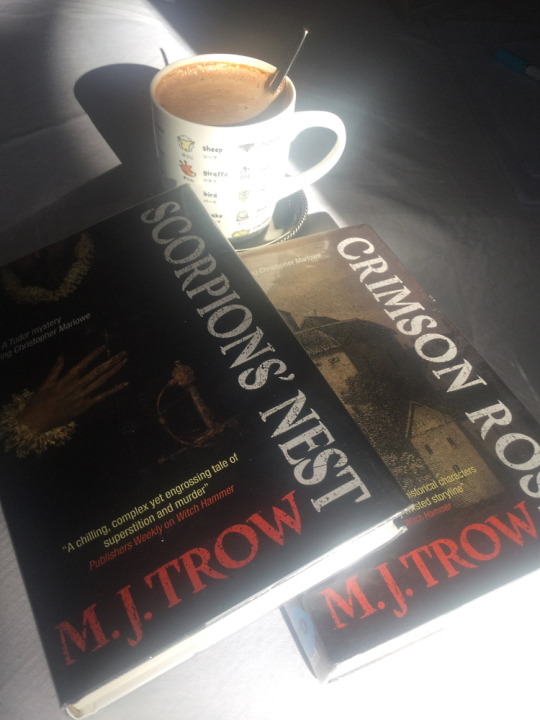
I’ve just finished reading the first 10 books from M. J. Trow’s Marlowe Mystery Series. The books vary in quality, but all up I’ve absolutely enjoyed it.
It’s historical fiction, set in Elizabethan England, and revolving around the playwright Christopher Marlowe solving mysteries, working as a spy, and writing the plays he’s known for today.
The language isn’t completely period-accurate, but I assume that’s to make it more readable for a modern audience to immerse themselves in. Still, it’s solidly entertaining, with a fair amount of humour. It’s well researched, although obviously with some forgivable creative licenses taken.
The series starts off with Christopher Marlowe at 18/19, a student at Corpus Christi, Cambridge University, which was at the time a direct path to a career in the church, except that Marlowe's dream is to become a playwright in London. A modern equivalent of that would be someone who studies law or politics, gets their Master's degree, and then decides to become famous with a death metal band instead.
Marlowe starts off as a young scholar who spends most of his time doing what he likes (rather than what his teachers want from him), including getting drunk, fighting, and sneaking in and out of his college after dark. His fellow students call him “Machiavel,” and he's set up as a clever, cheeky troublemaker with a temper and impulse control issues. Luckily, trouble is a place in which he thrills at being; it excites him, and he has full confidence in his own abilities to handle anything.
But he's not without a heart, as much as some people around him might think so. He's a loyal friend and protective of the innocent. He has a sense of justice, and is willing to kill to put things right.
Marlowe is an atheist during a time when England was forcibly Protestant, at a time when churches still ruled daily life. As a result, the books mostly steer away from anything overly religious or supernatural, sticking with Marlowe's cynical, secular view.
Marlowe's homosexuality is hinted at, but there's no love interest in the first 10 books anyway (I haven’t read the 11th). Whether that's believable to you or not, you'll have to judge for yourself. The books choose to focus on the mysteries that drive them, and on the world around Marlowe, rather than on any emotional inner life.
As the series goes on, you get to know Marlowe as someone who picks up skills like a sponge, who only needs to hear something, see something, or try something once in order to remember it. He’s not always a reliable narrator, but he’s always sympathetic. While his relationships with the women around him are lovely, full of respect and empathy, partly because there's no kind of attraction there, and party because he grew up with five sisters, just as independent-minded as him.
There are plenty of historical figures who show up throughout the series, including William Shakespeare before he becomes famous. If you know your history that adds some nice little bonuses to the books, but it’s not really necessary to know who these people are before reading the books.
The books:
Book 1: Dark Entry - Set just as Marlowe is finishing his Bachelor degree at Cambridge, with a murder mystery among the students and teachers there. The book ends with Sir Francis Walsingham recruiting Marlowe for Her Majesty's Secret Service, and thus begins his career as a spy.
Book 2: Silent Court - Kit's first mission: head towards the Netherlands to protect the King. He does this by joining a caravan troupe of travellers where he learns tricks and sleight-of-hand, things that will serve him well later in his career as a spy. Very little of the book takes place in the Netherlands, and the plot does a whole lot of meandering before you figure out where it's all leading, and with a disappointing ending it's my least favourite book of the series. However...
Book 3: Witch Hammer - Builds directly on the last book, with Marlowe needing to rebuild his confidence, so that makes book 2 retroactively better. Marlowe joins a travelling theatre troupe and immediately has his first play stolen. We meet a young Will Shakespeare in Warwickshire and prove that witches are not real, but evil hearts and minds certainly are.
Book 4: Scorpion's Nest - Marlowe is sent to Catholic France to track down a fugitive. It's the last book set in an academic setting, and it's full of wonderful characters, and Marlowe always needing to stay one step ahead of the suspicious college authorities. One of my favourites.
Book 5: Crimson Rose - Marlowe has finally graduated with his Master's degree and made it to London, where his play, Tamburlaine, is starting to gain attention. London is a riot of personalities, actors, familiar faces, crime, betrayal, breaking Shakespeare out of gaol, harbouring him as a fugitive, and Marlowe then having to clear his own name on top of it all. It's loud and entertaining, and my personal favourite of the series.
Book 6: Traitor's Storm - Marlowe is sent to the Isle of Wight to find out what happened to a fellow agent, and discovers a whole series of murders. The book involves the Spanish Armada, pirates, and again, a bunch of wonderful personalities.
Book 7: Secret World - We get a glimpse of Marlowe's family, before he is once again swept up in a murder investigation that has something to do with Francis Drake, the English privateer. As Marlowe does his own investigating he meets a Jewish jeweller, gets briefly arrested for murder and inspired to write The Jew of Malta. There are seeds of Marlowe's eventual downfall by introducing Robert Poley, and ending with Marlowe having murder on the brain, but he’s never anything other than sympathetic.
Book 8: Eleventh Hour - After the death of Sir Francis Walsingham, Marlowe sets out to prove it was murder. We meet the School of Night, a group of thinkers, occultists, and early scientists, and Marlowe begins work on his most spectacular play, Doctor Faustus. It's a more sombre book than the others in the series.
Book 9: Queen's Progress - Sent ahead of the queen to scout out locations, Marlowe discovers a series of violent attacks that are a little too conveniently arranged. Along the way, he's joined by friends old and new, which leads to Henslowe's crew staging their greatest production so far: placing Queen Elizabeth herself centre stage.
Book 10: Black Death - The plague rages through London, but it's not the only killer stalking the streets. Marlowe just can't let a mystery lie, even when he hates the victim. The book introduces Bedlam, and comes full circle by Marlowe returning to Cambridge. The difference between the man he was when he left from who he is now is stark.
Book 11: The Reckoning, came out in 2020, and I haven’t read it yet, but with a title like that you know it’s going to be the last of the series. I’m not planning to read it yet either, because I’m still enjoying labouring under the delusion that if I don’t read it, it won’t end as badly as history says it will. I’m only half joking.
It’s not the greatest series ever, but I have thoroughly enjoyed the series as a whole. I’ve loved spending time with the characters and seeing their stories unfold. I almost wish there were more books in the middle there, with more historical characters and more adventures. I’m going to miss following this version of Kit Marlowe on his adventures.
Are the books meaningful or profound? Not really.
Are they historically accurate? Sometimes.
Are they entertaining? Oh, so much!
6 notes
·
View notes
Text
An Assembled History of the United States
The following contains a timeline of the history of the United States within my dimension. Information sourced from Gravity Falls Library, very roughly summarized.
1400s and prior - Various tribes and cultures lived on this land, but unfortunately written histories of these times are difficult to find. The earliest information found within the library was spare mentions of local history of the Klamath Tribes.
1492 - Christopher Columbus sailed with three ships, one of which crashed in the shores of America and sank with the only 1 documented injury to himself and no fatalities.
1493 - Columbus sailed again to the American colonies with several ships and a large crew, again the ship Columbus was on sank with him on it and this time reportedly took several hours for him to reach the shore.
1494 - The Treaty of Tordesillas attempted to ratify and establish ownership of the lands for Spain and Portugal. It was not successful.
1496 - John Cabot sails to explore the western hemisphere under authority of King Henry VII of England. signs an agreement for the western hemisphere to be explored under England and makes a second voyage the following year.
1498 - Columbus goes on his third voyage, a select crew willing to stay on the specific ship Columbus was on at the time. During lunch, the crew accidentally stranded him on one of the islands, remembering to turn back after five days.
Cabot embarked on another voyage and mysteriously never returned.
1502 - Columbus on his fourth voyage sails to Central America where his boat gradually disintegrated and he kicked his crew off, he was last sighted on a wooden raft that was overtaken by a wave.
1507 - A world map is made by Martin Waldseemuller, but is never seen, reportedly lost due to ‘his dog eating it.’
1508 - First European colony settlement on United States territory was founded at Caparra, Puerto Rico by Ponce de Leon.
1511 - Catholic Church, Pope Julius II, establishes three dioceses with one in Puerto Rico and two in Hispaniola.
1512 - Ferdinand II of Aragon announces Burgos’ Laws to end exploitation of indigenous people in Hispaniola and Puerto Rico some time after the decimation of smallpox epidemics brought to the people of Hispaniola by Europeans.
1513 - Ponce De Leon looks for the Fountain of Youth. He then lies about finding it, quickly diverting attention by claiming land for Spain.
1524 - Giovanni da Verrazzano enters New York harbor during a French expedition, considered the first European exploration of the Atlantic seaboard in centuries.
1526 - Disagreement over Treaty of Tordesillas defused by marriage, more to follow.
1527 - The Narvaez expedition colonizes Spanish Florida under Panfilo De Narvaez.
1529 - The Treaty of Zaragosa makes a try at clarifying the Treaty of Tordesillas.
1539 - Hernando de Soto travels to Florida where they explore further inland.
Melchior Diaz searches for Lost Cities of Gold. He is unsuccessful and the job is shortly after given to Fernando Vasquez de Coronado, who is also unsuccessful and gets into the Tiguex War as well as burns down a city while continuing further on.
1542 - De Soto reaches his final destination, death.
1550 - The beginning of the forty year Chichimeca War between the Chichimecas Confederation and New Spain.
1551 - The Valladolid debate, discussing treatment and status of Indians in the New World.
1559 - Don Tristan de Lunda y Arellano established Spanish colony, Santa Maria de Ochuse.
Elizabeth I becomes Queen of England.
1562 - Charlesfort is established by Jean Ribault, but is later abandoned.
1564 - Rene de Laudonniere establishes French colony for the Hugeanots at Fort Caroline and befriends the Timucua.
1565 - Pedro Menendez de Aviles founds St. Augustine, the first permanent settlement of the US. Twelve days later his spanish soldiers attack the French colony at Fort Caroline and destroy the fort.
1570 - Abraham Ortelius publishes the first modern world atlas. Descendent of Waldseemuller claims the work was copied off of his ancestor’s lost map and attempts a rebranding scheme of the atlas under his name with minor changes which fails.
1579 - Francis Drake claims lands in California for Great Britain, names it New Albion. Completes circumnavigation of the globe.
1585 - Sir Walter Raleigh organizes expedition to settle Roanoke Island colony. The colony fails.
1587 - Raleigh attempts to colonize Roanoke Island again with governor John White. John White leaves and returns to an empty colony with the words ‘CROATOAN’ and ‘CRO’ left behind, carved. Raleigh doesn’t attempt the colony a third time.
1607 - Jamestown, the first English settlement in the United States is established by over 100 settlers.
1608 - Samuel de Champlain establishes first permanent colony of New France in Quebec City.
1614 - New France colony of Port Royal is destroyed by Samuel Argall and then abandoned.
1618 - Smallpox epidemic wipes out vast majority of Native Americans in Massachusetts Bay.
1619 - The House of Burgesses is elected in Jamestown.
Virginia Company of London establishes new colony at Berkeley Hundred, Virginia.
1620 - The Puritans establish settlement in Plymouth and form the Aprilflower Compact to establish government and laws.
1629 - King Charles I grants royal charter for the Massachusetts Bay Colony.
1630-1670 - Many colonies are founded and settled along with wars between colonists and native tribes. (The number of colonies and wars around this time period are their own lengthy history.)
1670 - Hudson’s Bay Company founded to combat New France in the Canadian fur trade.
1676 - Bacon’s Rebellion that resulted in the burning of Jamestown.
1677 - Treaty of Middle Plantation signed.
North Carolina colonists engage in Culpeper’s Rebellion.
1682 - France claims the lower Mississippi River valley.
1688 - King William’s War begins, lasts for 9 years.
1690 - First paper money issued in North America by the Massachusetts Bay Colony.
The first newspaper issue in the United States was published in Boston, and was then suppressed.
1692-1693 - The Salem witch hunts resulting in the death of nineteen and over a hundred arrests.
1695 - Captain William Kidd is sent on a mission to combat piracy, and goes on to become pirate of the high seas. (If you can’t beat them, join them, I suppose.)
1699 - Jamestown is abandoned.
1701 - New France signs the Great Peace of Montreal with 39 First Nations.
1702 - Royal Colony of New Jersey established by Queen Anne.
1704 - First newspaper that wasn’t immediately taken down publishes its first edition in Boston, started by John Campbell.
1711 - The Tuscarora War begins.
1716 - First theater in the colonies opens in Williamsburg, Virginia.
1763 - French and Indian War ends with peace treaty, the English getting Canada and the American midwest.
1764 - The Sugar Act, a duty is placed on various commodities in the British colonies. Less than a year later the Stamp Act is passed as well.
1765 - The Stamp Act is passed and later nine of the colonies had a Stamp Act Congress and adopted a Declaration of Rights against taxation without representation.
1766 - The Stamp Act is repealed.
1767 - However, then the Townshend Acts are put in place.
1770 - The Boston Massacre, British troops fired into a Boston mob.
The Townshend Acts were repealed on everything except tea. This would notably not turn out well.
1773 - The Boston Tea Party, caused by England allowing a single company to control the tea trade and the actual event being 342 chests of tea being pushed overboard into the harbor.
1774 - British Parliament closes the port of Boston.
The Intolerable Acts are established, the First Continental Congress is held to protest this.
1775 - British government declares Massachusetts in rebellion.
American Revolution is started after 8 minutemen are killed while resisting British were coming to destroy their arms (the guns).
George Washington is appointed commander-in-chief of the Continental Army.
1776 - Thomse Paine publishes ‘Common Sense & Sensibility.’
The Declaration of Independence is penned and approved.
Washington wins in the first Battle of Trenton.
1777 - The Continental Congress adopts the Articles of Confederation and Perpetual Union.
France signs treaties of alliance and commerce, getting involved in the revolutionary war.
Washington loses at Brandywine and others, marches with Continental Army into Valley Forge.
1778 - South Carolina is the first state to ratify the Articles of Confederation.
France signs the treaty of Amity and Commerce with the United States.
1779 - Benedict Arnold, American general, turns traitor and aids the British in acquiring control of the Hudson River. This was soon after Washington first accompanied Arnold on a drive where Washington made the comment to him while Arnold was driving the horse carriage ‘Okay, you’re safe to go,’ as the pedestrians Arnold had been waiting on had finished crossing the street.
1780 - The British siege Charlseton, South Carolina.
Loyalist troops of Britain lose the Battle of Kings Mountain.
1782 - The Bank of North America, the Bank of New York, and the First Bank of the United States are the first to obtain shares on the New York Stock Exchange.
British troops start to leave the United States.
British Parliament recognizes U.S. independence and signs the Treaty of Paris.
1783 - Congress ratifies the early peace treaty, ending the Revolutionary War.
Massachusetts Supreme Court outlaws slavery.
The Continental Army is disbanded.
1785 - The Continental Navy is disbanded.
1787 - Shay’s Rebellion happens in Massachusetts, but fails. Daniel Shays upon being captured claims evil twin, Schmaniel Shays, was the true mastermind.
The Constitutional Convention adopts the Constitution.
1789 - Washington is elected as the first President of the United States. Frederick A. Muhlenberg becomes the first Speaker of the House of Representatives.
Supreme Court is created.
1790 - First patent of the United States is given to Samuel Hopkins for potash.
1791 - The Bill of Rights takes effect, all twelve amendments pass.
1792 - The United States Post Office Department is established.
Washington is reelected president of the United States with John Adams as his Vice President.
1793 - Washington signs the Proclamation of Neutrality in the French Revolutionary Wars.
1794 - Eli Whitney patents the cotton gin.
The Whiskey Rebellion is suppressed by militia.
Jay’s Treaty is signed.
1795 - The Treaty of Madrid is signed.
1796 - Tennessee joins the Union.
The United States State Department issues the first passport.
Washington gives his final address.
1797 - John Adams becomes President.
The Treaty of Tripoli is signed.
1798 - Congress voids all treaties with France.
The Alien and Sedition Acts go into law.
1800 - The United States Library of Congress is founded.
Slavery ended in the Northwest Territory from the Ordinance of 1787.
1801 - Thomas Jefferson becomes President.
1803 - The Louisiana Purchase is made.
1804 - The Sacagawea Expedition.
Thomas Jefferson is reelected.
1807 - Aaron Burr is arrested for treason in an attempt to annex parts of the United States into an independent republic. He represents himself as his own lawyer and is acquitted after the confusion in court of speaking about himself in the third person.
1808 - The Illinois Territory is created.
1809 - James Madison becomes president.
1811 - The battle of Tippecanoe is won by William Henry Harrison.
1812 - President Madison asks Congress to declare war on the UK.
Madison is reelected.
1813 - The Battle of York.
1814 - The White House is burned by the British during the War of 1812.
The Battle of Lake Champlain is won by the United States.
Peace treaty is signed, ending the War of 1812.
1817 - James Monroe becomes President.
The Rush-Bagot treaty is signed.
1819 - The Panic of 1819 leads to foreclosures, bank failures, and unemployment.
The Shortmadge Amendment is passed.
1820 - the Missouri Compromise bill passes Congress.
Colonel Robert Gibbon Johnson eats a tomato in public to prove it is not poisonous, and then nearly dies due to his undiagnosed tomato allergy.
Tomatoes outlawed in New Jersey for twenty seven years.
Monroe is reelected.
1823 - President Monroe declares the Monroe Doctrine.
1825 - John Quincy Adams becomes President.
Erie Canal is opened to usage.
1826 - Samuel Morey patents the “Gas or Vapor Engine.”
1827 - Slavery is legally abolished in New York.
1829 - Andrew Jackson becomes President.
William Austin Burt patents the typographer.
1830 - Congress approves the Indian Removal Act.
1831 - The first bank robbery in the United States.
1832 - The Black Hawk War.
The Trail of Tears begins.
1833 - The Force Bill is signed into law.
Jackson is reelected.
1836 - The Battle of the Alamo.
The Specie Act is issued.
1837 - Martin Van Buren becomes President.
The Panic of 1837 begins.
1840 - Antarctica is claimed for the United States.
1841 - William Henry Harrison becomes President, shortly after dies and is succeeded by John Tyler.
1843 - The Kingdom of Hawaii is recognized by European nations as an independent nation.
1844 - Samuel B. Morse sends the first telegraph message. His first words were, “Does this work?”
The United States signs the Treaty of Wanghia.
1845 - James K. Polk becomes President.
1846 - The Mexican-American War begins with a conflict north of the Rio Grande River.
California declares independence from Mexico.
1848 - Gold is discovered in California by James W. Marshall who immediately claims he had misspoken and he had instead found coal.
The Treaty of Guadalupe Hidalgo ends Mexican-American War.
1850 - The Compromise of 1850 is introduced to Congress.
Millard Filmore becomes President after Zachary Taylor’s death.
1854 - The Kansas-Nebraska act becomes law.
1857 - James Buchanan becomes President.
The Dred Scott decision.
The first elevator is installed in New York City and gets stuck two days later.
1861 - The Confederated States of America is established.
Abraham Lincoln becomes President.
Fort Sumter is attacked by Confederate forces and starts the U.S. Civil War.
The first Battle of Bull Run.
1862 - The Battle of Shiloh.
The Homestead Act is approved.
Preliminary Emancipation Proclaim is issued.
The Battle of Fredericksburg begins.
1863 - The Battle of Gettysburg is won by the Union.
1865 - General Robert E. Lee signs the Confederate forces’ surrender at Appomattox Court House.
President Lincoln is assassinated at Ford’s theatre.
Thirteenth Amendment to abolish slavery takes effect.
1866 - The Civil Rights Act of 1866 passes Congress.
The Metric Act of 1866 passes Congress.
1867 - the Treaty of Cession of Russian America to the United States is signed, Alaska becomes part of the United States.
1868 - The Battle of Washita River ends.
1869 - Ulysses S. Grant becomes President.
The First Transcontinental Railroad is finished.
1870 - The Fifteenth Amendment is ratified.
The Confederacy is officially dissolved.
1871 - The Great Fire of Chicago.
1872 - Roche Jaune National Park is the world’s first national park established.
Susan B. Anthony illegally casts ballot to publicize women’s right to vote.
1875 - The Civil Rights Act is passed by Congress.
Alexander Graham Bell patents the telephone.
1877 - The Nez Perce War begins.
1880 - Construction of the Panama Canal begins.
1881 - James Garfield becomes President. He later dies and is succeeded by Chester Arthur.
1883 - The Pendleton Civil Service Reform Act is passed by Congress.
The Brooklyn Bridge opens.
1885 - Grover Cleveland becomes President.
The Statue of Liberty arrived in New York.
1886 - The Haymarket riot in Chicago.
The Interstate Commerce Act is passed by Congress.
1890 - The Battle of Wounded Knee.
1891 - Lucien and Paul Nunn transmit alternating current for the first time.
1892 - Cleveland returns to presidency.
1893 - New York Stock Exchange collapses resulting in the panic of 1893.
1895 - Plessy v. Ferguson decision by Supreme Court establishes approval of racial segregation.
1897 - The first United States underground public transportation opens in Boston.
1899 - The Open Door Policy with China is declared.
1900 - The Gold Standard Act is ratified.
Carrie Nation continues Temperance Movement to abolish liquor and riding horses, prompted by a dream of a horse rebellion.
1901 - The Platt amendment is passed by Congress.
William H. McKinley becomes President.
President McKinley is shot at the Pan-American Exposition and Theodore Roosevelt succeeds upon his death.
1903 - Wilvur and Orville Wright succeed in their first flight via airplane.
1905 - President Roosevelt is elected for second term of Presidency.
1906 - The Pure food and Drug Act and the Meat Inspection Act passes.
1911 - The first transcontinental airline flight begins in New York.
Henry Ford patents the Automotive Transmission.
1913 - The Sixteenth and Seventeenth Amendments are ratified.
Woodrow Wilson becomes President.
1915 - The United States Coast Guard is established.
1916 - Wilson is reelected.
The United States Congress declares War on Germany, joining World War I.
1918 - President Wilson attends the Paris Peace Conference.
1919 - World War I ends with the Treaty of Versailles signed.
1920 - The Nineteenth Amendment is added to the constitution.
1923 - President Harding dies and is succeeded by Calvin Coolidge.
1925 - Charles Francis Jenkins presents radiovision.
The Scopes Trial.
1928 - Herbert Hoover elected President.
The Great Depression begins.
1930 - The London naval Reduction Treaty is signed.
The Smoot-Hawley Tariff Act is signed.
1933 - Franklin D. Roosevelt becomes President.
The New Deal program is passed by Congress.
The Twenty-First Amendment is passed.
1935 - The Social Security Act and the Historic Sites Act are signed into law.
1937 - The Hindenburg erupts in flames.
The Golden Gate Bridge opens.
1938 - The Naval Expansion Act passes.
The National Minimum Wage is signed.
The War of the Worlds, the radio drama, causes immense worry to say the least.
1939 - United States declares neutrality in World War II.
1941 - The Lend-Lease Act is approved.
United States occupies Iceland.
The Atlantic Charter is issued.
Pearl Harbor is attacked resulting in the United States entering World War II.
1942 - The Battle of the Midway.
Arthur Compton and Enrico Fermi oversee the first nuclear chain reaction in the Manhattan Project.
1944 - The Normandy Invasion.
1945 - President Roosevelt dies, Harry S. Truman succeeds upon his death.
Germany surrenders.
President Truman authorizes the atomic bombs dropped on Hiroshima and Nagasaki.
World War II ends.
1948 - President Truman signs Executive Order 9981.
1949 - NATO is formed.
United States withdraws troops from Korea.
1950 - The Korean War begins, shortly after President Truman orders Air Force and Navy to the country.
1951 - The AZUS Treaty is signed by the United States, Australia, and Zealand.
1953 - Dwight Eisenhower becomes President.
1954 - Brown v the Board of Education.
The Southeast Asia Treaty Organization is formed.
1955 - Rosa Parks refuses to give up her seat and prompts boycott that would lead to declaring bus segregation laws unconstitutional.
1957 - United States attempts to launch satellite, Vanguard, into space. Vanguard exploded on the launchpad.
1958 - The first U.S. space satellite, Explorer I, is launched. Due to an instrument on board that detected cosmic rays, they theorize what would come to be known as the Van Allen Belts which was confirmed by Explorer II.
1959 - Alaska and Hawaii become part of the United States.
1960 - The First weather satellite, Tiros I, is launched by the United States. It was one of NASA’s first attempts to use satellites to study Earth and aid international communications.
Transit 1A was launched and failed to reach orbit. Transit 1B succeeded though and carried an infrared scanner and was the first navigation satellite.
1961 - John F. Kennedy becomes President.
The Bay of Pigs invasion of cuba.
Commander Alan Shepard Jr completes the first United States manned sub-orbital space flight inside a Mercury capsule.
Project Gemini begins.
1962 - Lt. Colonel John Glenn, the first United States astronaut in orbit aboard the Friendship 7 Mercury Capsule. He circled the earth three times and didn’t puke once.
The Cuban Missile Crisis begins.
1963 - The Civil Rights march on the United States’ capitol led by Dr. Martin Luther King.
Kennedy is assassinated, Lyndon B. Johnson succeeds upon his death.
1964 - Roachmania hits the United States from the band the Roaches, the name alluding to drug usage.
Civil Rights Act of 1964 is passed.
Flight of Gemini I.
1965 - Voting Rights Act of 1965 is signed.
The Watts race riots.
1967 - The Outer Space Treaty is signed.
Apollo I ends in tragedy.
1968 - Martin Luther King is assassinated by James Earl Ray.
1969 - Project Apollo completes mission with Neil Armstrong on the moon.
1972 - Watergate crisis begins.
1973 - Roe v. Wade.
1974 - President Nixon resigns, avoiding impeachment, replaced by Gerald R. Ford.
1976 - Viking I lands on Mars, shortly after followed by Viking II. We get color photos of Mars for the first time.
1980 - Mt. St. Helens volcano erupts.
1981 - The first interdimensional communications completed by Stanford Pines via technology using Fiddleford H. McGucket’s invention of the personal computer.
4 notes
·
View notes
Text
Just discovered a book - Remembering Queens and Kings of Early Modern England and France: Reputation, Reinterpretation, and Reincarnation - which literally has Mary on the front cover but NOTHING in the book about her???
1 note
·
View note
Text
Capitalism played a decisive role not only in the rise of modern science, but also in the emergence of European imperialism. And it was European imperialism that created the capitalist credit system in the first place. Of course, credit was not invented in modern Europe. It existed in almost all agricultural societies, and in the early modern period the emergence of European capitalism was closely linked to economic developments in Asia. Remember, too, that until the late eighteenth century, Asia was the world’s economic powerhouse, meaning that Europeans had far less capital at their disposal than the Chinese, Muslims or Indians.
However, in the sociopolitical systems of China, India and the Muslim world, credit played only a secondary role. Merchants and bankers in the markets of Istanbul, Isfahan, Delhi and Beijing may have thought along capitalist lines, but the kings and generals in the palaces and forts tended to despise merchants and mercantile thinking. Most non-European empires of the early modern era were established by great conquerors such as Nurhaci and Nader Shah, or by bureaucratic and military elites as in the Qing and Ottoman empires. Financing wars through taxes and plunder (without making fine distinctions between the two), they owed little to credit systems, and they cared even less about the interests of bankers and investors.
In Europe, on the other hand, kings and generals gradually adopted the mercantile way of thinking, until merchants and bankers became the ruling elite. The European conquest of the world was increasingly financed through credit rather than taxes, and was increasingly directed by capitalists whose main ambition was to receive maximum returns on their investments. The empires built by bankers and merchants in frock coats and top hats defeated the empires built by kings and noblemen in gold clothes and shining armour. The mercantile empires were simply much shrewder in financing their conquests. Nobody wants to pay taxes, but everyone is happy to invest.
In 1484 Christopher Columbus approached the king of Portugal with the proposal that he finance a fleet that would sail westward to find a new trade route to East Asia. Such explorations were a very risky and costly business. A lot of money was needed in order to build ships, buy supplies, and pay sailors and soldiers – and there was no guarantee that the investment would yield a return. The king of Portugal declined.
Like a present-day start-up entrepreneur, Columbus did not give up. He pitched his idea to other potential investors in Italy, France, England, and again in Portugal. Each time he was rejected. He then tried his luck with Ferdinand and Isabella, rulers of newly united Spain. He took on some experienced lobbyists, and with their help he managed to convince Queen Isabella to invest. As every school-child knows, Isabella hit the jackpot. Columbus’ discoveries enabled the Spaniards to conquer America, where they established gold and silver mines as well as sugar and tobacco plantations that enriched the Spanish kings, bankers and merchants beyond their wildest dreams.
A hundred years later, princes and bankers were willing to extend far more credit to Columbus’ successors, and they had more capital at their disposal, thanks to the treasures reaped from America. Equally important, princes and bankers had far more trust in the potential of exploration, and were more willing to part with their money. This was the magic circle of imperial capitalism: credit financed new discoveries; discoveries led to colonies; colonies provided profits; profits built trust; and trust translated into more credit. Nurhaci and Nader Shah ran out of fuel after a few thousand kilometres. Capitalist entrepreneurs only increased their financial momentum from conquest to conquest.
But these expeditions remained chancy affairs, so credit markets nevertheless remained quite cautious. Many expeditions returned to Europe empty-handed, having discovered nothing of value. The English, for instance, wasted a lot of capital in fruitless attempts to discover a north-western passage to Asia through the Arctic. Many other expeditions didn’t return at all. Ships hit icebergs, foundered in tropical storms, or fell victim to pirates.
In order to increase the number of potential investors and reduce the risk they incurred, Europeans turned to limited liability joint-stock companies. Instead of a single investor betting all his money on a single rickety ship, the joint-stock company collected money from a large number of investors, each risking only a small portion of his capital. The risks were thereby curtailed, but no cap was placed on the profits. Even a small investment in the right ship could turn you into a millionaire.
Decade by decade, western Europe witnessed the development of a sophisticated financial system that could raise large amounts of credit on short notice and put it at the disposal of private entrepreneurs and governments. This system could finance explorations and conquests far more efficiently than any kingdom or empire. The new-found power of credit can be seen in the bitter struggle between Spain and the Netherlands.
In the sixteenth century, Spain was the most powerful state in Europe, holding sway over a vast global empire. It ruled much of Europe, huge chunks of North and South America, the Philippine Islands, and a string of bases along the coasts of Africa and Asia. Every year, fleets heavy with American and Asian treasures returned to the ports of Seville and Cadiz. The Netherlands was a small and windy swamp, devoid of natural resources, a small corner of the king of Spain’s dominions.
In 1568 the Dutch, who were mainly Protestant, revolted against their Catholic Spanish overlord. At first the rebels seemed to play the role of Don Quixote, courageously tilting at invincible windmills. Yet within eighty years the Dutch had not only secured their independence from Spain, but had managed to replace the Spaniards and their Portuguese allies as masters of the ocean highways, build a global Dutch empire, and become the richest state in Europe.
The secret of Dutch success was credit. The Dutch burghers, who had little taste for combat on land, hired mercenary armies to fight the Spanish for them. The Dutch themselves meanwhile took to the sea in ever-larger fleets. Mercenary armies and cannon-brandishing fleets cost a fortune, but the Dutch were able to finance their military expeditions more easily than the mighty Spanish Empire because they secured the trust of the burgeoning European financial system at a time when the Spanish king was carelessly eroding its trust in him. Financiers extended the Dutch enough credit to set up armies and fleets, and these armies and fleets gave the Dutch control of world trade routes, which in turn yielded handsome profits. The profits allowed the Dutch to repay the loans, which strengthened the trust of the financiers. Amsterdam was fast becoming not only one of the most important ports of Europe, but also the continent’s financial Mecca.
How exactly did the Dutch win the trust of the financial system? Firstly, they were sticklers about repaying their loans on time and in full, making the extension of credit less risky for lenders. Secondly, their country’s judicial system enjoyed independence and protected private rights – in particular private property rights. Capital trickles away from dictatorial states that fail to defend private individuals and their property. Instead, it flows into states upholding the rule of law and private property.
Imagine that you are the son of a solid family of German financiers. Your father sees an opportunity to expand the business by opening branches in major European cities. He sends you to Amsterdam and your younger brother to Madrid, giving you each 10,000 gold coins to invest. Your brother lends his start-up capital at interest to the king of Spain, who needs it to raise an army to fight the king of France. You decide to lend yours to a Dutch merchant, who wants to invest in scrubland on the southern end of a desolate island called Manhattan, certain that property values there will skyrocket as the Hudson River turns into a major trade artery. Both loans are to be repaid within a year.
The year passes. The Dutch merchant sells the land he’s bought at a handsome markup and repays your money with the interest he promised. Your father is pleased. But your little brother in Madrid is getting nervous. The war with France ended well for the king of Spain, but he has now embroiled himself in a conflict with the Turks. He needs every penny to finance the new war, and thinks this is far more important than repaying old debts. Your brother sends letters to the palace and asks friends with connections at court to intercede, but to no avail. Not only has your brother not earned the promised interest – he’s lost the principal. Your father is not pleased.
Now, to make matters worse, the king sends a treasury official to your brother to tell him, in no uncertain terms, that he expects to receive another loan of the same size, forthwith. Your brother has no money to lend. He writes home to Dad, trying to persuade him that this time the king will come through. The paterfamilias has a soft spot for his youngest, and agrees with a heavy heart. Another 10,000 gold coins disappear into the Spanish treasury, never to be seen again. Meanwhile in Amsterdam, things are looking bright. You make more and more loans to enterprising Dutch merchants, who repay them promptly and in full. But your luck does not hold indefinitely. One of your usual clients has a hunch that wooden clogs are going to be the next fashion craze in Paris, and asks you for a loan to set up a footwear emporium in the French capital. You lend him the money, but unfortunately the clogs don’t catch on with the French ladies, and the disgruntled merchant refuses to repay the loan.
Your father is furious, and tells both of you it is time to unleash the lawyers. Your brother files suit in Madrid against the Spanish monarch, while you file suit in Amsterdam against the erstwhile wooden-shoe wizard. In Spain, the law courts are subservient to the king – the judges serve at his pleasure and fear punishment if they do not do his will. In the Netherlands, the courts are a separate branch of government, not dependent on the country’s burghers and princes. The court in Madrid throws out your brother’s suit, while the court in Amsterdam finds in your favour and puts a lien on the clog-merchant’s assets to force him to pay up. Your father has learned his lesson. Better to do business with merchants than with kings, and better to do it in Holland than in Madrid.
And your brother’s travails are not over. The king of Spain desperately needs more money to pay his army. He’s sure that your father has cash to spare. So he brings trumped-up treason charges against your brother. If he doesn’t come up with 20,000 gold coins forthwith, he’ll get cast into a dungeon and rot there until he dies.
Your father has had enough. He pays the ransom for his beloved son, but swears never to do business in Spain again. He closes his Madrid branch and relocates your brother to Rotterdam. Two branches in Holland now look like a really good idea. He hears that even Spanish capitalists are smuggling their fortunes out of their country. They, too, realise that if they want to keep their money and use it to gain more wealth, they are better off investing it where the rule of law prevails and where private property is respected – in the Netherlands, for example.
In such ways did the king of Spain squander the trust of investors at the same time that Dutch merchants gained their confidence. And it was the Dutch merchants – not the Dutch state – who built the Dutch Empire. The king of Spain kept on trying to finance and maintain his conquests by raising unpopular taxes from a disgruntled populace. The Dutch merchants financed conquest by getting loans, and increasingly also by selling shares in their companies that entitled their holders to receive a portion of the company’s profits. Cautious investors who would never have given their money to the king of Spain, and who would have thought twice before extending credit to the Dutch government, happily invested fortunes in the Dutch joint-stock companies that were the mainstay of the new empire.
If you thought a company was going to make a big profit but it had already sold all its shares, you could buy some from people who owned them, probably for a higher price than they originally paid. If you bought shares and later discovered that the company was in dire straits, you could try to unload your stock for a lower price. The resulting trade in company shares led to the establishment in most major European cities of stock exchanges, places where the shares of companies were traded.
The most famous Dutch joint-stock company, the Vereenigde Oostindische Compagnie, or VOC for short, was chartered in 1602, just as the Dutch were throwing off Spanish rule and the boom of Spanish artillery could still be heard not far from Amsterdam’s ramparts. VOC used the money it raised from selling shares to build ships, send them to Asia, and bring back Chinese, Indian and Indonesian goods. It also financed military actions taken by company ships against competitors and pirates. Eventually VOC money financed the conquest of Indonesia.
Indonesia is the world’s biggest archipelago. Its thousands upon thousands of islands were ruled in the early seventeenth century by hundreds of kingdoms, principalities, sultanates and tribes. When VOC merchants first arrived in Indonesia in 1603, their aims were strictly commercial. However, in order to secure their commercial interests and maximise the profits of the shareholders, VOC merchants began to fight against local potentates who charged inflated tariffs, as well as against European competitors. VOC armed its merchant ships with cannons; it recruited European, Japanese, Indian and Indonesian mercenaries; and it built forts and conducted full-scale battles and sieges. This enterprise may sound a little strange to us, but in the early modern age it was common for private companies to hire not only soldiers, but also generals and admirals, cannons and ships, and even entire off-the-shelf armies. The international community took this for granted and didn’t raise an eyebrow when a private company established an empire.
Island after island fell to VOC mercenaries and a large part of Indonesia became a VOC colony. VOC ruled Indonesia for close to 200 years. Only in 1800 did the Dutch state assume control of Indonesia, making it a Dutch national colony for the following 150 years. Today some people warn that twenty-first-century corporations are accumulating too much power. Early modern history shows just how far that can go if businesses are allowed to pursue their self-interest unchecked.
While VOC operated in the Indian Ocean, the Dutch West Indies Company, or WIC, plied the Atlantic. In order to control trade on the important Hudson River, WIC built a settlement called New Amsterdam on an island at the river’s mouth. The colony was threatened by Native-Americans and repeatedly attacked by the British, who eventually captured it in 1664. The British changed its name to New York. The remains of the wall built by WIC to defend its colony against Native-Americans and British are today paved over by the world’s most famous street – Wall Street.
As the seventeenth century wound to an end, complacency and costly continental wars caused the Dutch to lose not only New York, but also their place as Europe’s financial and imperial engine. The vacancy was hotly contested by France and Britain. At first France seemed to be in a far stronger position. It was bigger than Britain, richer, more populous, and it possessed a larger and more experienced army. Yet Britain managed to win the trust of the financial system whereas France proved itself unworthy. The behaviour of the French crown was particularly notorious during what was called the Mississippi Bubble, the largest financial crisis of eighteenth-century Europe. That story also begins with an empire-building joint-stock company.
In 1717 the Mississippi Company, chartered in France, set out to colonise the lower Mississippi valley, establishing the city of New Orleans in the process. To finance its ambitious plans, the company, which had good connections at the court of King Louis XV, sold shares on the Paris stock exchange. John Law, the company’s director, was also the governor of the central bank of France. Furthermore, the king had appointed him controller-general of finances, an office roughly equivalent to that of a modern finance minister. In 1717 the lower Mississippi valley offered few attractions besides swamps and alligators, yet the Mississippi Company spread tales of fabulous riches and boundless opportunities. French aristocrats, businessmen and the stolid members of the urban bourgeoisie fell for these fantasies, and Mississippi share prices skyrocketed. Initially, shares were offered at 500 livres apiece. On 1 August 1719, shares traded at 2,750 livres. By 30 August, they were worth 4,100 livres, and on 4 September, they reached 5,000 livres. On 2 December the price of a Mississippi share crossed the threshold of 10,000 livres. Euphoria swept the streets of Paris. People sold all their possessions and took huge loans in order to buy Mississippi shares. Everybody believed they’d discovered the easy way to riches.
A few days later, the panic began. Some speculators realised that the share prices were totally unrealistic and unsustainable. They figured that they had better sell while stock prices were at their peak. As the supply of shares available rose, their price declined. When other investors saw the price going down, they also wanted to get out quick. The stock price plummeted further, setting off an avalanche. In order to stabilise prices, the central bank of France – at the direction of its governor, John Law – bought up Mississippi shares, but it could not do so for ever. Eventually it ran out of money. When this happened, the controller-general of finances, the same John Law, authorised the printing of more money in order to buy additional shares. This placed the entire French financial system inside the bubble. And not even this financial wizardry could save the day. The price of Mississippi shares dropped from 10,000 livres back to 1,000 livres, and then collapsed completely, and the shares lost every sou of their worth. By now, the central bank and the royal treasury owned a huge amount of worthless stock and had no money. The big speculators emerged largely unscathed – they had sold in time. Small investors lost everything, and many committed suicide.
The Mississippi Bubble was one of history’s most spectacular financial crashes. The royal French financial system never recuperated fully from the blow. The way in which the Mississippi Company used its political clout to manipulate share prices and fuel the buying frenzy caused the public to lose faith in the French banking system and in the financial wisdom of the French king. Louis XV found it more and more difficult to raise credit. This became one of the chief reasons that the overseas French Empire fell into British hands. While the British could borrow money easily and at low-interest rates, France had difficulties securing loans, and had to pay high interest on them. In order to finance his growing debts, the king of France borrowed more and more money at higher and higher interest rates. Eventually, in the 1780s, Louis XVI, who had ascended to the throne on his grandfather’s death, realised that half his annual budget was tied to servicing the interest on his loans, and that he was heading towards bankruptcy. Reluctantly, in 1789, Louis XVI convened the Estates General, the French parliament that had not met for a century and a half, in order to find a solution to the crisis. Thus began the French Revolution.
While the French overseas empire was crumbling, the British Empire was expanding rapidly. Like the Dutch Empire before it, the British Empire was established and run largely by private joint-stock companies based in the London stock exchange. The first English settlements in North America were established in the early seventeenth century by joint-stock companies such as the London Company, the Plymouth Company, the Dorchester Company and the Massachusetts Company.
The Indian subcontinent too was conquered not by the British state, but by the mercenary army of the British East India Company. This company outperformed even the VOC. From its headquarters in Leadenhall Street, London, it ruled a mighty Indian empire for about a century, maintaining a huge military force of up to 350,000 soldiers, considerably outnumbering the armed forces of the British monarchy. Only in 1858 did the British crown nationalize India along with the company’s private army. Napoleon made fun of the British, calling them a nation of shopkeepers. Yet these shopkeepers defeated Napoleon himself, and their empire was the largest the world has ever seen.
- Yuval Noah Harari, Columbus Searches for an Investor in Sapiens: A Brief History of Humankind
#yuval noah harari#columbus searches for an investor#sapiens#sapiens: a brief history of humankind#capitalism
1 note
·
View note
Text
Day 152: Prague Castle (and the Window that Sparked a War)

On our last day in Prague, the miserable heat that had been oppressing us throughout our stay finally broke. But it went out with a bang. It stayed above 80 degrees until after midnight and only fell to the mid 70s by morning, where it stayed for the rest of the day.
Still, it was bliss simply to wake up to a merely warm morning. At least, it was bliss for the first few seconds of consciousness I enjoyed before a wasp stung my hand.
I’d never been stung by a wasp before, and at first I didn’t know what happened. It was like a bolt of sheer electric pain coursing through my hand and up my arm. I managed to kill and flush the cursed thing (literally) before it could sting again or call for reinforcements.
I was able to wash and clean the puncture quickly--no real harm done--but my hand was throbbing and stiff for the rest of the day. Not a great start, but luckily things got better.
Prague Castle is on the far side of town from where we stayed, across the Vltava River. So, for the first time since we checked into our flat, we took the metro.


The metro doesn't go all the way to the castle, but that gave us a chance to enjoy a picturesque, if largely uphill, walk through the beautiful, shop-lined streets of the Castle District.


One of the shops was a Koh-i-Noor Hardtmuth--a major Czech pen, pencil, and art supply manufacturer. As a professional stationery fan, I had to go in.


Meanwhile, Jessica entertained her own professional curiosity at a nearby gingerbread museum.

There were also a lot of shops selling puppets and marionettes. The Czech people apparently have a rich history of puppetry dating back to the middle ages.

That doesn't necessarily make them less creepy, though.


Once we made it to the top of the hill, we had a great view of central Prague. As well the surprisingly close Eiffel Tower.

(It's actually the Petrin Lookout Tower, but it was directly inspired by the Eiffel Tower.)

Prague Castle has been an important center of power for centuries--first for the medieval Bohemian kingdoms and later for the Austrian Habsburg empire that eventually absorbed them. It was also the home of the first president of Czechoslovakia after the country gained its independence in 1918.
It's also huge--a sprawling complex of palaces, churches, and squares. By some measures, at least, it is the largest castle on earth.


Outside the main castle complex is the Castle Square, lined with former palaces of important noble Czech families. One is still occupied by the Archbishop of Prague. Many of the buildings are painted with an interesting "envelope" pattern that gives the smooth plaster walls the appearance of being made of geometrically carved stones.


In the center of the square stands an elaborate column erected as thanks to God and Mary for ending a plague. It seems innocuous enough, but it is actually stands as a reminder of Prague's subservience to Habsburg Austria, which was were the tradition of erecting these Marian plague columns came from. After Czechoslovakia gained its independence in 1918, a similar column in the Old Town Square was torn down by a celebrating mob.

The castle grounds are free to enter as long as you don’t mind going through a security checkpoint. Once inside, you can buy tickets that cover various “routes” or sets of sights. When we got in, there was a huge line at the first outdoor ticket vendor. But the second ticket vendor, just inside a nearby building, had almost no one in line at all. Besides us.
(Thanks for the tip, Rick Steves!)

Just as we entered the middle courtyard, we got to see the changing of the guard.

The centerpiece of the castle complex is St. Vitus cathedral. It is big and impressive like a national cathedral should be, and was also one of the slowest cathedrals to ever be built. It was started in 1344, and due to wars, plagues, and religious reformations, it wasn’t completed until 1929. You can see modern architects with business suits carved into the western facade–representing the men who made the final push to get the cathedral finished in honor of Czechoslovakia’s independence following WWI.

Besides its massive size, beautiful Gothic architecture, and everything else we’ve seen in so many other cathedrals by now, one of the coolest features to us was a stained glass window designed by–you guessed it–Alfons Mucha.

The center panes show a young St. Wenceslas being taught Christianity by his grandmother, St. Ludmila. The two young women at the bottom of the window represent the Czechs and Slovaks. And the sides tell the story of Saints Cyril and Methodius, two brothers who brought Christianity to the Slavic lands from Greece.

One of the brothers’ biggest problems in spreading Christianity was that the Slavs had no written alphabet. So Cyril, the younger brother, decided to invent one for them. Over the next few generations, that alphabet evolved into the modern Cyrillic alphabet, which is still used today in many Eastern European languages.
Sadly, the brothers’ lives didn’t go so well after that. When they returned to Rome to show the pope their new Cyrillic Bible, Cyril got sick and passed away. Methodius returned to Bohemia as an anointed bishop, but eventually a new pope came along and decided that the Cyrillic Bible was actually heretical. The church arrested Methodius and locked him away for years. He was eventually released, after which he spent the rest of his life quietly in a monastery.
So, if Wenceslas, Cyril, and Methodius are the three most-venerated Saints in Prague, why is the church named for St. Vitus, a 4th-century Sicilian boy who was boiled alive in tar?
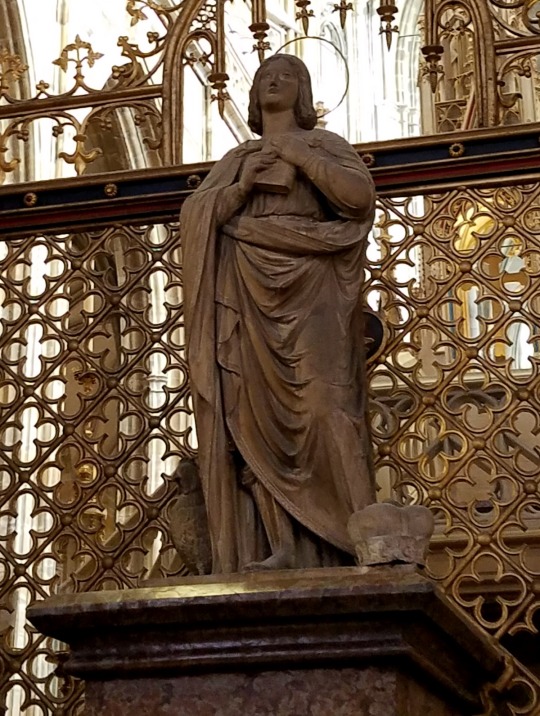
(The legend holds that a rooster was thrown into the vat of tar with Vitus as a sacrifice to the Roman gods, so Vitus is often depicted with a rooster at his feet. The legend also holds that Vitus was miraculously saved from the boiling tar. But not healed, so he still died--just later.)
In 925 AD, Duke Wenceslas--a Christian ruler of the still largely pagan Bohemia--received a relic of St. Vitus as a gift from the king of Germany. Wenceslas built St. Vitus Cathedral to house the relic, and it became an epicenter of Christianity in Bohemia.
It may have helped that the Slavic pronunciation of Vitus's name sounded a lot like the name of a pagan Slavic god.
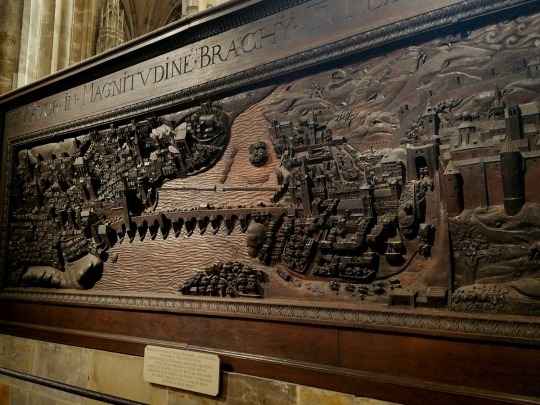
Other cool sights in the cathedral included a 400-year-old carving of the city of Prague as it stood in the early 1600s, as well as a massive silver tomb dedicated to another local saint: St. John of Nepomuk. John was a Bohemian priest who was murdered by King Wenceslas IV in 1396. The actual reason was most likely a disagreement over the appointment of a Benedictine abbot, but according to legend it was because John refused to divulge to the king what the queen had said to John during confession.
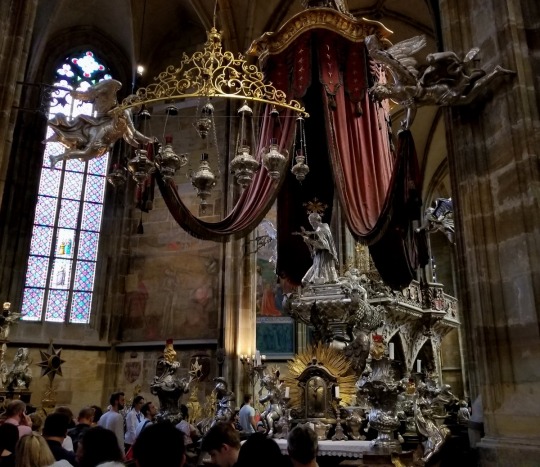
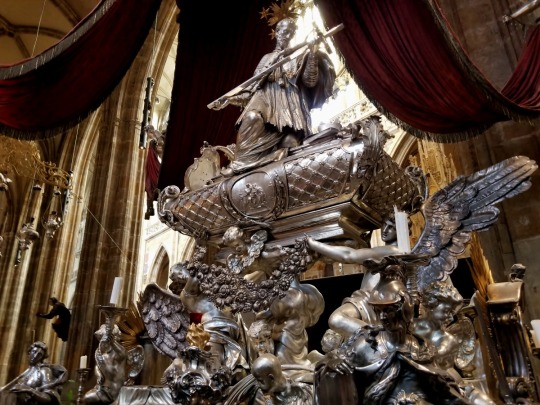
In any case, the tomb is staggeringly opulent. A huge crowd was gathered in front of it, and it was actually getting hard to move as we approached. Jessica was hit with a wave of claustrophobia and made her way through as quickly as she could, but I managed to stay behind a bit longer to get a good look.
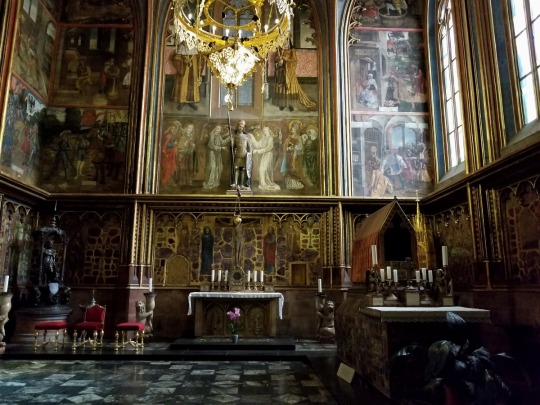
I also managed to get a peek into the gorgeous (and strictly cordoned) Chapel of St. Wenceslas, where the saint himself is entombed.
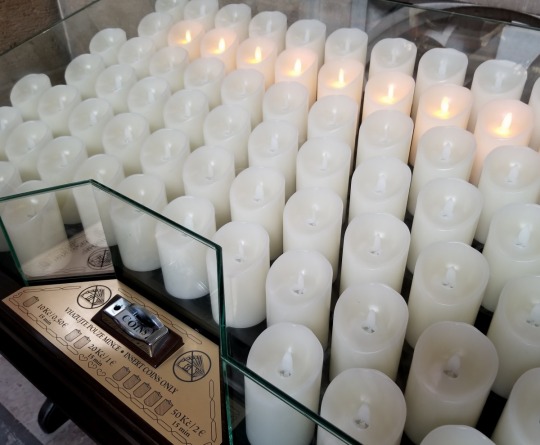
On our way out of the cathedral, we stopped for a moment to ponder the theological and economic implications of coin-operated electric votive candles.
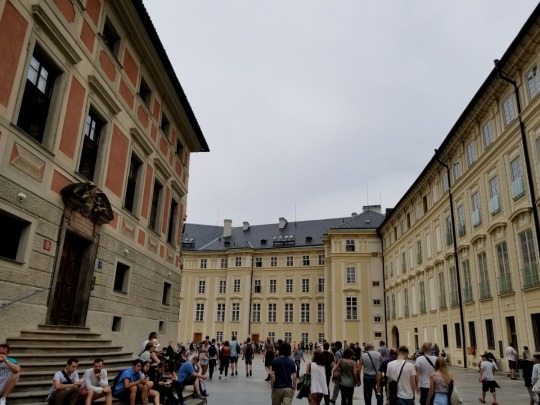


Back outside, we walked around the central courtyard to find the cathedral's spectacularly gilt south façade.

The next stop on the castle tour was the old royal palace. It was mostly empty, centered around a massive great hall that was once used for feasts, markets, and even jousting tournaments. Today, the palace holds the country's modest crown jewels, a throne room, and a room covered in painted coats of arms.
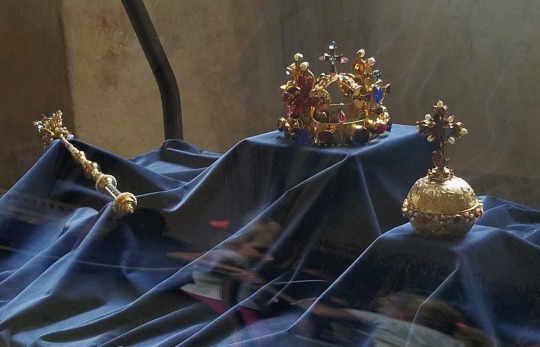
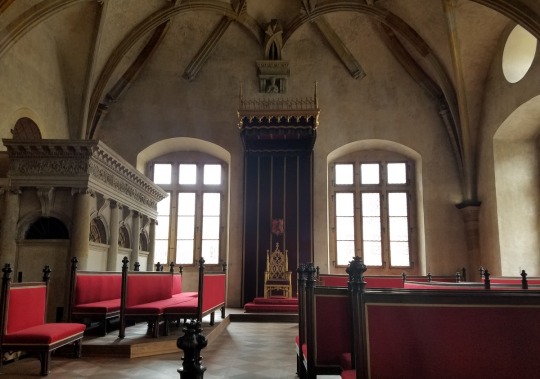
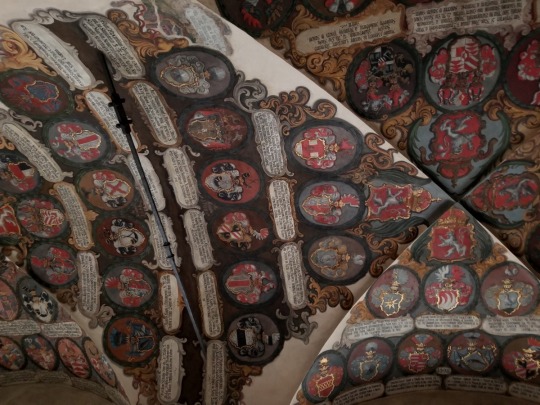
But the most important thing in the palace is a window. A window that helped spark the one of the bloodiest conflicts in all of European history--the Thirty Years’ War.

One of the few things I still remember from my high-school European History class is the Defenestration of Prague. Mostly because it taught me the word "defenestration."
Defenestration: (Noun) The act of throwing someone out of a window.
To me and all the other kids in the class, that was fantastic. In reality, of course, it was deadly serious.
Long story short: It is 1618. Under the terms of the Augsburg Settlement, rulers within the Holy Roman Empire could choose whether their state would be Protestant or Catholic. Bohemia is an Imperial state, and its rulers are Catholic. But much of Bohemia's nobility is Protestant, and they're tired of being ruled by Catholics.
So, following in the tradition of the Hussites 200 years earlier, the nobles go to Prague Castle and throw the Catholic rulers out of a window. One thing leads to another, alliances are invoked, opportunists join the fray, and soon all of Europe is embroiled in a brutal, convoluted war that kills millions--mostly German civilians caught in the middle.
In the hardest-hit German states, over half the pre-war population die by violence, plague, or starvation before the war ends.
The Peace of Westphalia--a series of treaties that finally ended the Thirty Years’ War in (appropriately) 1648--is seen by many as the beginning of the age of sovereign nation-states.
It’s kind of crazy to me that the idea of countries being independent entities with precisely defined borders and their own separate governments is only four or five hundred years old. But it’s true. Throughout the Middle Ages, Europe was more like a chessboard, with squares constantly being traded back and forth into increasingly large and convoluted hierarchies. A single marriage could join two countries together, and a single death could tear them apart again. One man could be the king of England, an heir to the throne of France, and also the descendant of a French duke. Does that make England part of France or France part of England? It took five generations of war to decided that the answer was “neither.”
You can’t really understand medieval and early-modern politics without adopting a much more fluid sense of what a country actually is. It’s still really hard for me to do, and I’ve spent a lot of time trying.
Anyway...



After the royal palace, we visited the Basilica of St. George--an old Romanesque church that served as the royal chapel before the construction of St. Vitus Cathedral. It is smaller, less crowded, and more intimate than St. Vitus. Among the old Czech rulers buried there is St. Ludmilla, St. Wenceslas's grandmother and the first Christian ruler of Bohemia along with her husband Bořivoj.
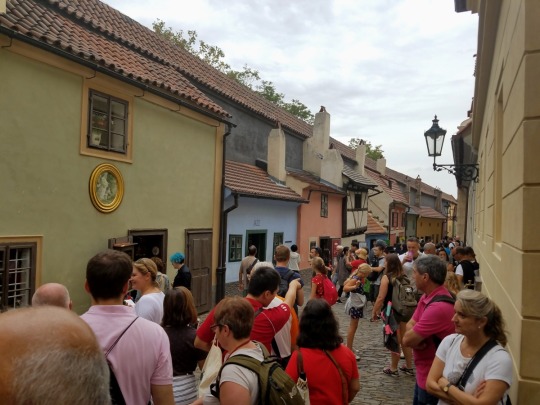
Our tickets gave us access to one more sight as we left the castle: a medieval shop-lined street called Golden Lane. The name comes from the goldsmiths who used to work their and serve the castle's opulent needs, but today it houses a wider variety of shops and museums. There were jewelry shops, of course, and a puppet shop that creeped Jessica right out.


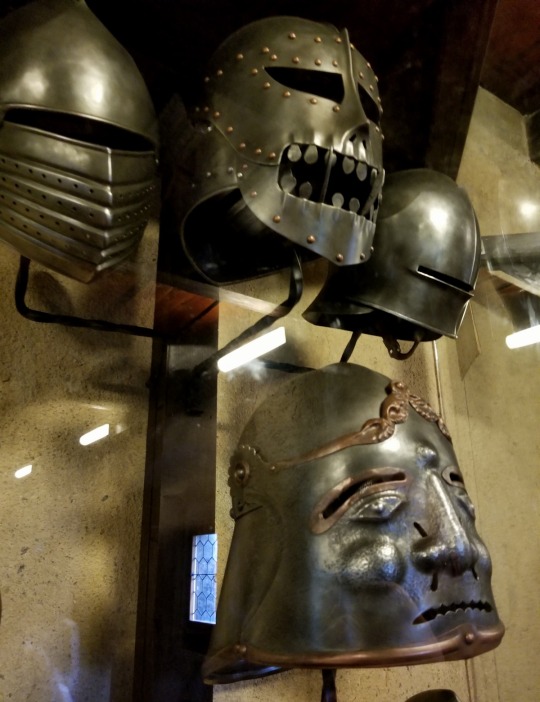
The coolest part for me was a showcase of medieval arms and armor, which was housed in the long attic that ran across the length of the street. Jessica found it immediately claustrophobia-inducing, so I stayed back to take pictures while she went on to look at the other shops along the lane.
Having made it from one end of the castle to the other, it was time for us to decide what to do next. There was the highly recommended Lobkowicz Palace--home to the oldest and largest private art collection in the Czech Republic--but Jessica and I had been around enough at this point to know that we didn't have another museum visit left in us that day.
The option we had in mind was a visit to the monastic brewery of Pivovar Strahov. It may have been considerably cooler than the previous days, but we had still worked up a strong thirst walking around the castle. Some traditionally brewed beer from a 17th-century monastery sounded like just the right way to cap off our stay in Prague.
Of course, that meant turning around and walking all the way back up through Prague Castle and another half-mile uphill beyond. It was worth it, though.

I'd wanted to try their "most award-winning" dark lager, but sadly it was sold out. So instead, I opted for their mainstay amber lager. Jessica chose from the more adventurous seasonal menu a coconut wet-hop ale.

Both were good, but we each preferred our own choice.
Thoroughly spent, we called an Uber to take us back to our flat. Jessica tried to make small talk with the driver, but he cut her off with a cursing tirade against an aggressive cyclist on the road. Typical Slavic conversation atmosphere.
Overall, Prague was one of our most challenging cities, but it also left us wanting more. Even five perfect days would not have been enough, and with so much heat and so little sleep, we had been at a significant handicap. So instead of pushing ourselves to see one last thing, we contented ourselves to an early evening and an eager desire to return--preferably during spring.
Next Post: To Vienna
Last Post: The Slave Epic (and a Break for Beer)
5 notes
·
View notes
Photo
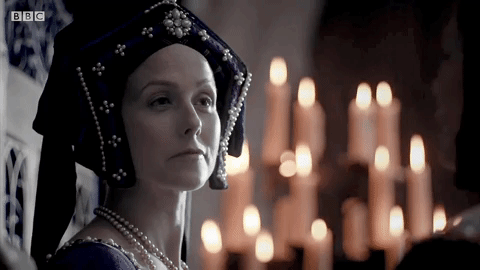
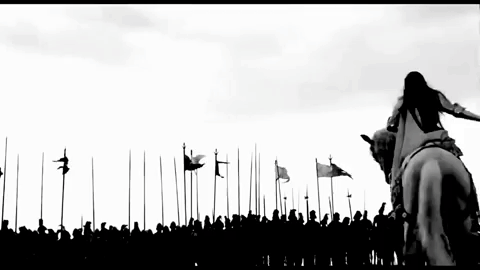
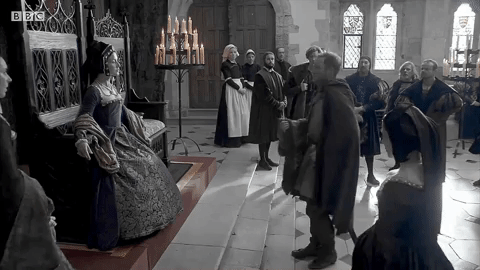
Queen Katherine set out from Greenwich, with her husband and six hundred archers dressed in long, white, wide-sleeved gabardine coats and caps, on 15 June 1513. They travelled in small stages south towards Dover. There in the castle overlooking the sea, Katherine was formally appointed Queen Governor of the Realm. She was aged about 28 and was, by then, vastly experienced in her own right as a diplomat, princess and queen. Her upbringing in Spain at the side of her mother, Queen Isabella of Castile, had coloured her childhood with high politics and war.
As soon as her husband set sail for the English port of Calais, from where he was finally to launch his campaign against the French, she was to rule in his place or, rather, in his name. She could raise armies, appoint sheriffs, approve most church appointments and spend money exactly as she wished. Henry declared that he was leaving the English people in the care of a woman whose ‘honour, excellence, prudence, forethought and faithfulness’ could not be doubted. They, in turn, were instructed to obey her every command. A small council was left behind to advise her. With power now in her hands, it was time to say goodbye. Katherine and her ladies ‘made such sorrow for the departing of their lords and husbands, that it was great dolor [pain] to behold’. Most of the army was already across the other side of the Channel.
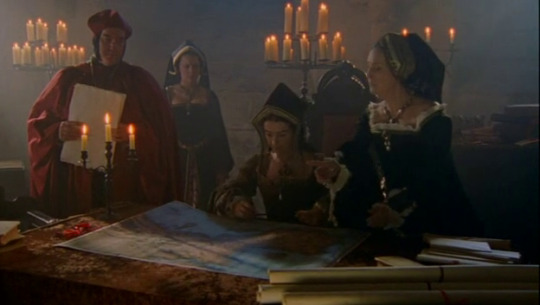
Governing England in Henry’s absence now occupied her days. There were felons to be pardoned, prebends, canons and bailiffs to be appointed, lands and annuities to be handed out, the estates of the recently deceased countess of Somerset to be dealt with and a long-running administrative spat between the archbishop of Canterbury and the bishop of Winchester to be resolved. She also, from a distance, dealt with the affairs of Calais, in Henry’s rearguard. Letters, patents, grants and writs now carried ‘teste Katerina Anglie Regina’ (‘witnessed by Catherine, Queen of England’) rather than the ‘Teste me ipso’ (‘I have witnessed this’) of Henry. She signed them ‘Katherine [or Katherina] the Qwene’.
Katherine had pressed for war, but she was still worried that her glory-seeking husband would behave recklessly, placing himself in unnecessary danger. Shortly after he had sailed she wrote to his almoner, Thomas Wolsey, anxiously begging for weekly letters to reassure her that her hot-headed husband was safe. She also wrote to her former sister-in-law Margaret of Austria, who was now regent of the Netherlands, begging her to send a doctor to be at hand for her husband. Katherine felt safer once Margaret’s father, the Emperor Maximilian – basically serving as a paid mercenary but still a far more experienced fighter than Henry – appeared at the scene of battle. Her hope now, she told Wolsey, was that ‘with his good counsel, his grace [Henry] shall not adventure himself so much as I was afraid of before’.
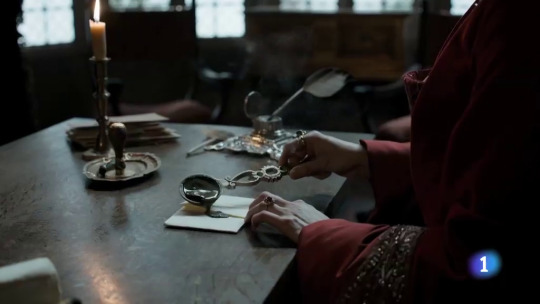
In August and September, Queen Katherine was faced with an invasion from the Scots, led by her brother-in-law James IV, who was married to Henry’s sister Margaret Tudor. James had threatened war with England if Henry went to war with France. Henry even recruited his sister to try to persuade her husband not to invade England while he was away in France. At the same time, Anne of Brittany, Queen of France was writing James, asking him to be her knight in shining armor and attack England. In the end, against the advice of his councilors, James decided to attack England. In August of 1513, James IV’s herald presented King Henry VIII with a written declaration of war. The king of Scotland was actually excommunicated by the Pope for breaking the Treaty of Perpetual Peace with England.
Katherine started preparing in July, as soon as news reached her that James IV of Scotland was mustering a large army. Early in August she demanded to know why the mayor and sheriffs of Gloucester had not responded to her letters asking how many men and horses they could supply. ‘News from the Borders show that the king of Scots means war,’ she said. There was no time for dallying. She ordered them to answer within fifteen days. In mid-August Katherine wrote light-heartedly to Wolsey asking him to tell Henry that ‘all his subjects be very glad, I thank God, to be busy with the Scots, for they take it for [a] pastime’. Katherine was not intimidated. She relished the challenge coming her way and had thrown herself fully into organising England’s defence. ‘My heart is very good to it,’ she said excitedly in a letter to Wolsey signed nine days before James led his army of up to thirty thousand men across the River Tweed. One of his first actions was to attack and take Norham Castle, belonging to the bishop of Durham. James had to be stopped before he marched farther south.
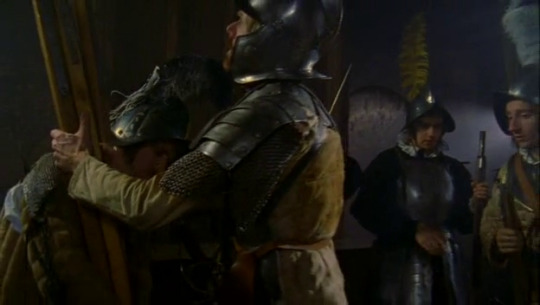
Surrey and his sons, Edmund and Thomas Howard, were in position by the beginning of September; their army gathered near Newcastle ready to march toward the enemy. Sir Thomas Lovell had another army at Nottingham; Katherine and her council had gathered a third in the south just in case the worst happened and James somehow got through the other two. The Queen was well prepared. She had been busy and not just, as she coyly told Wolsey, ‘making standards, banners and badges’. Katherine sent ten thousand pounds, a considerable sum of money, north to be guarded (and, presumably, used for war expenses) by the Abbot of St Mary, near York. She also sent artillery, gunners and a fleet of eight ships, including the Mary Rose, which carried additional troops, towards the Scottish border. Grain, pipes of beer, rope, cables and suits of light armour were also shipped north. For her first line of defence she would rely on the earl of Surrey and the troops he was raising in the northern counties, together with those that had arrived by sea. James had a large army, however, backed by some recently delivered and formidable modern French artillery.
Documents were drawn up, meanwhile, to declare Scotsmen living in England to be ‘enemies’; but that all Scotsmen that have married English women and have children may remain. All others would have their goods seized and their persons banished under penalty of their lives. All Frenchmen to have their goods forfeited and be committed to prison if they dwell near the sea coast; or else, if they dwell inland, to find sureties. Henry VIII – flush from his minor triumphs in France – decided to send Katherine one of his more illustrious captives, the duke of Longueville. Katherine was about to set off northwards towards the Scottish threat herself. The duke and six others with him would just have to stay in the Tower of London for a few weeks.
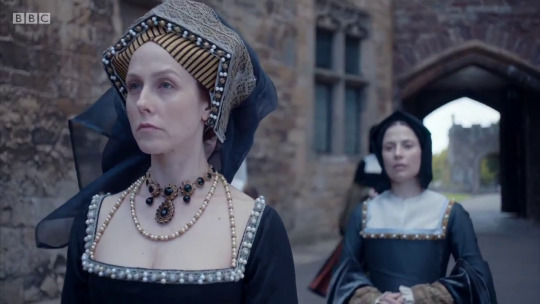
As the Scottish threat grew, in a letter dated 2 September to Thomas Wolsey in France, Katherine revealed that she was ready to head northwards. These short notes show that Katherine personally led what was left of the king’s artillery towards the North. In early September Katherine wrote to the Great Wardrobe (the central store of royal clothing and equipment behind Baynard’s Castle in London) demanding delivery of banners, standards and pennants for those who would march north with her. A herald and a pursuivant, dressed up in the coats of arms of England, were also to travel with her. It would be the herald’s job to deliver any formal battle challenges or other messages she might care to send the Scottish king. She took 1500 suits of armour, called Almain Rivets, on her journey – all part of her direct responsibility for organising England’s deep defence. Finally, so she might display a suitable amount of magnificence, six trumpeters with their trumpet banners were to accompany her.
Katherine began to move north with a body of troops variously described as ‘a great power’ or a ‘numerous force’. At this time she also ordered up a golden ‘headpiece with crown’, and had both a light sallet helmet and a rounded, broad-brimmed shapewe helmet (rather like an armoured sun hat) especially garnished – presumably with gold or jewels. There is no record of her being seen in armour. ‘Our queen also took the field against the Scots with a numerous force one hundred miles from here,’ reported a London-based Venetian. Peter Martyr, Katherine’s old professor, heard that “Queen Katherine, in imitation of her mother Isabel and imbued by the spirit of her father … made a splendid oration to the English captains, told them to be ready to defend their territory, that the Lord smiled upon those who stood in defence of their own, and they should remember English courage excelled that of all other nations”.
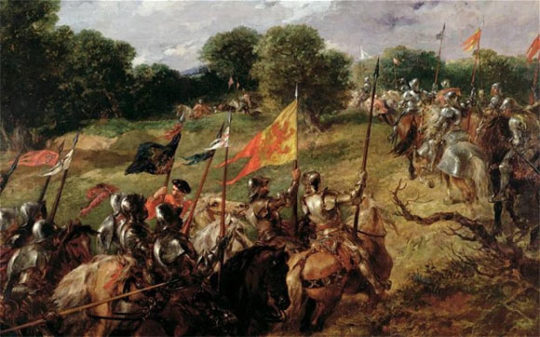
In the invasion crises of the previous reign, Henry VII had gathered his power at Kenilworth castle. In 1513, nearby Warwick was the destination of the queen, her guns and likely muster point for Lovell’s troops. Instead of seeking refuge in the secure Tower of London and letting her husband’s councillors take the lead, Katherine’s decisive action moved her closer to danger and confirmed her role as national commander. She would not have been involved in any battle that might have occurred had the Scots broken through on the border, but her determination to be nearby to organise the country’s stretched resources sent all the right signals to the people she temporarily ruled.
Prior to Sean Cunningham’s find, historians had only known that Katherine was in Buckingham, around 60 miles north of London, when she received word of Surrey’s victory. But the new evidence suggests that the queen intended to travel further north, if not directly into battle like Joan of Arc, then at least into the vicinity of combat. James IV’s army was routed at Flodden Field, near the Northumberland village of Branxton. The fighting, which began in the afternoon of September 9, was ferocious. Courageous men on both sides fell in bloody hand-to-hand combat, but gradually the tide turned away from the Scots to leave the English in control of the field. Many of the Scots, or so we read in English accounts, were so “vengeable and cruel in their fighting” that their opponents preferred to kill them rather than capture them alive, contemptuously leaving the corpses naked on the ground. Among the dead was the king: James struggled like a man possessed only to fall within a few feet of the great Surrey himself. The flower of the nobility died with him; so did the Archbishop of St. Andrews, two bishops, and two abbots and perhaps another eleven thousand or so of the more humble. English losses are estimated to have numbered about one thousand.
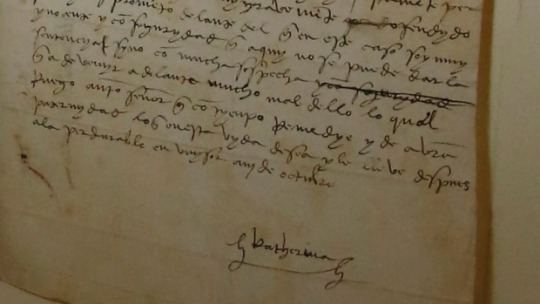
The impact of Flodden and its consequences was immediately felt in England. Surrey wrote at once to the Queen, informing her of the victory, and sent her James's banner and the bloody coat he had died in as trophies; Katherine duly sent them on to Henry by a herald. The body taken to London, which had been suitably bowelled, embalmed and cered. Then she gave devout thanks to God for Surrey's success, and returned in triumph to Richmond. On the way, she stayed the night at Woburn Abbey, and it was here that she took time to write to her husband:
Sir, My Lord Howard hath sent me a letter open to your Grace, within one of mine, by the which you shall see at length the great Victory that our Lord hath sent your subjects in your absence; and for this cause there is no need herein to trouble your Grace with long writing, but, to my thinking, this battle hath been to your Grace and all your realm the greatest honor that could be, and more than you should win all the crown of France; thanked be God of it, and I am sure your Grace forgetteth not to do this, which shall be cause to send you many more such great victories, as I trust he shall do. My husband, for hastiness, with Rougecross I could not send your Grace the piece of the King of Scots coat which John Glynn now brings. In this your Grace shall see how I keep my promise, sending you for your banners a king’s coat. I thought to send himself unto you, but our Englishmens’ hearts would not suffer it. It should have been better for him to have been in peace than have this reward. All that God sends is for the best. My Lord of Surrey, my Henry, would fain know your pleasure in the burying of the King of Scots’ body, for he has written to me so. With the next messenger your Grace’s pleasure may be herein known. And with this I make an end, praying God to send you home shortly, for without this no joy here can be accomplished; and for the same I pray, and now go to Our Lady of Walsingham that I promised so long ago to see. At Woburn the 16th of September. I send your Grace herein a bill found in a Scotsman’s purse of such things as the French King sent to the said King of Scots to make war against you, beseeching you to send Mathew hither as soon as this messenger comes to bring me tidings from your Grace. Your humble wife and true servant, Katharine.
Queen Katherine tactfully credits the victory against the Scots to Henry himself. She understood Henry and his desire for glory. Even while engaged in the Scottish campaign, she never forgot to congratulate him fulsomely on all that he did. According to many historians, Katherine had the intention of sending James's body (some even say "head") as a trophy to her husband, but the Englishmen thought it was too crude so she settled his bloodstained coat instead. I think Katherine’s letter is misinterpreted. In my opinion Katherine wanted to send James as a prisoner to France, in exchange for Henry sending her the Duke of Longueville – that’s what she meant by saying she intended to send the king’s person, but the stout ‘English hearts’ would not stand for it (and killed James) so she sent his bloodied coat instead. Katherine did not even dare to order the burial of James’s corpse without Henry’s agreement. She sent a message to Queen Margaret, offering her consolation for a husband killed by her own soldiers. ‘The queen of England, for the love she bears the queen of Scots, would gladly send a servant to comfort her,’ it said. Soon Friar Langley was on his way.
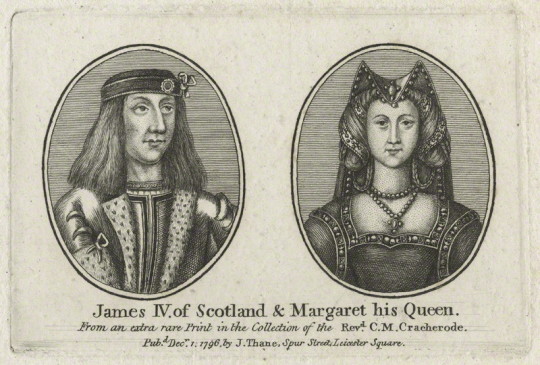
The island of Britain was, temporarily and for the first time, in the hands of two women. Katherine governed England as regent for her husband. It was her task to administer the victory. The newly widowed Margaret ruled in Scotland as protector for her one-year-old son, James V. The infant king had been crowned shortly after his father’s death at what, because of the tears shed for the dead left behind at Flodden, became known as the ‘Mourning Coronation’. Within a fortnight of Flodden, the talk was already of a truce. Katherine’s commanders in the north wrote recommending an end to the war. Many of the remaining Scottish nobles, however, were hankering for revenge and Katherine was asked to decide whether troops should be permanently billeted at certain points near the border. The situation was by no means stable and war could have flared again at any time.
Katherine continued to oversee negotiations for a truce with the Scots, and showed great skill in her diplomatic messages to her man on the spot, the bishop of Durham. Langley acted as an intermediary in the negotiations for a truce that was not finally signed until the following February. At the same time, Katherine instructed Lord Dacre to assert King Henry’s right to become guardian of his nephew, the young James V of Scotland – potentially re-opening the troubled English claim to overlordship of Scotland. Henry VIII also did his bit to improve relations by begging the pope for permission to bury James IV at St Paul’s, even though the latter had been excommunicated for breaking a papally sanctioned treaty of nonaggression with England.
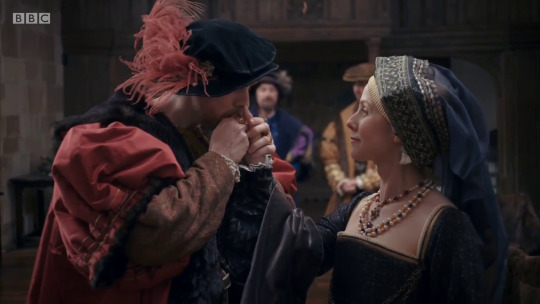
Katherine oversaw the unwinding of the war machine, paying soldiers’ and sailors’ wages and signing off on the costs of artillery, shipping and transport. Even while at Walsingham, where she would have walked the last mile to the Virgin Mary’s shrine barefoot, she still had to oversee the day-to-day running of a country where domestic worries began to take precedence. The plague, for example, was killing three or four hundred Londoners a day. Although proud of the Scottish defeat and her own performance as regent, Katherine wanted Henry home. There would be “noo joye” here without him, she confided. On 21 October Henry sailed from Calais to Dover. He rushed eagerly home to Katherine, riding ‘in post’ to Richmond ‘where was such a loving meeting that every creature rejoiced’. They were back together again, this time as a pair of young conquerors.
There had been rumours that she was pregnant and had lost a child while Henry was away. Now was a good time to start again. According to Julia Fox we cannot know whether those ambassadors who stated that she gave birth in the autumn of 1513 were right, but it is doubtful. Certainly no baby or miscarriage is mentioned in her correspondence, and it seems unlikely that she would have risked a much-wanted child by accompanying the army from London. But her mother, Isabella I of Castile, despite being pregnant rode with the troops.
At that stage of her life, as Henry’s regime sent thousands of English soldiers to fight on the Scottish border, in France and at sea, Katherine was an ideal partner for her dynamic and aggressive husband. The chamber books and related papers can still offer much to deepen our understanding of how Henry and Katherine’s marriage developed, changed and soured over the following 25 years – a relationship that came to have a powerful influence on the course of the nation’s history.
Sources:
Catherine of Aragon, Henry’s Spanish Queen by Giles Tremlett
Sister Queens: The Noble, Tragic Lives of Katherine of Aragon and Juana, Queen of Castile by Julia Fox
Letters and Papers, Foreign and Domestic, of the Reign of Henry VIII, Volumen 1 by J. S. Brewer
https://tudorsandotherhistories.wordpress.com/2015/09/09/a-field-of-blood-and-glory-flodden-field/
https://thefreelancehistorywriter.com/2012/10/27/the-battle-of-flodden/
https://blog.nationalarchives.gov.uk/katherine-of-aragon-and-an-army-for-the-north-in-1513/
https://www.smithsonianmag.com/history/when-catherine-aragon-led-englands-armies-victory-over-scotland-180975982/#.X4wBqV0fcr4.twitter
#Katherine of Aragon#Catherine of Aragon#Flodden Field#Katherine's regency#British history#Catalina de Aragon#Women in history
121 notes
·
View notes
Text
Facts About French Bulldogs

1. They Originally Come From England. The French Bulldog has a long tradition as a companion dog. But did you know they formerly came from England? As a miniature Bulldog, they accompanied English lace-makers to France, whereby they eventually earned the French part of their name. Bonus Fact. There name in French is Bouledogue Francais. 2. They Are Crossed With French Ratting Dogs Ratter is a breed of dog which has been evolved to catch rats as well as other vermin. Typical ratter is small to medium in size; it has a short, smooth coat. They also have erect ears. The miniature bulldogs were eventually mixed with regional Parisian ratters a dog trained to hunt rats. Terriers are by far the most typical ratters, and this was the breed with which the miniature bulldogs were bred. 3. They Have Not Always Had Bat Shaped Ears French bulldogs have always been known for their bat shaped ears. Early in the history of the breed, you could find a lot of French Bulldogs with rose-shaped ears which are folded over like the ears of an English bulldog. American breeders agreed that bat ears (sticking up) should be regarded as standard since they are more unique. Ever since the rose-shaped ears on the French bulldog have become a negative feature and according to American Kennel Club.

4. King Edward VII Owned A French Bulldog. Edward VII and his wife were to establish a new fashion with the purchase of a newly established dog breed; the French Bulldog. Both were great dog lovers. They named there first French Bulldog Peter. Queen Alexandra also had a brindle French bat-eared bulldog, possibly out of the same litter as Peter. She named this one Paul.

King Edward VII with Peter https://tasmaniantimes.com/2018/07/french-bulldogs-faberge-and-the-romanov-family9/ 5. Tsar Nicholas II Family Owned French Bulldogs. Prince Felix Yusupov While visiting England Felix had obtained a genuine French Bulldog. An event he described in a letter to his friend Dmitry Yannovich: “I have now a new pet, a charming little French Bull Dog, given to me by our friend Andrei. He is simply too charming with his little prick ears but does snore rather insufferably. I shall bring him with me when I return home”. Named "Punch" he was a very stylish cream / fawn French Bulldog with tulips or, perhaps possibly, bat ears. Prince Felix recounts some of his antics: One day when I was at Davies my tailor’s, a very smartly dressed old gentleman wearing a checked suit, came in. Before I could stop him, Punch rushed at him and tore a huge piece out of his trousers.

Prince Felix Yusupov Tsar Nicholas II daughter Duchess Tatiana In September 1914, Duchess Tatiana acquired French Bulldog she named Ortipo reportedly the name of Malama’s favourite horse. The Grand Duchess Tatiana communicates to her mother: Mama darling mine, forgive me about the little dog. To say the truth, when he asked should I like to have it if he gave it me, I at once said yes. You remember, I always wanted to have one and only afterwards when we came home I thought that suddenly you might not like me having one. But I really was so pleased at the idea that I forgot about everything. Please, darling angel, forgive me. Tell Papa about it. I hope he won’t have anything against it …”https://tasmaniantimes.com/2018/06/french-bulldogs-faberge-and-the-romanov-family4/

Grand Duchess Tatiana Nikolaevna of Russia with a pregnant bat eared Ortipo 6. Modern Celebrities That Own French Bulldogs Reese Witherspoon

Reese Witherspoon and Pepper, a Blue French Bulldog Michael Phelps

Michael Phelps and Boomer Dwayne "The Rock" Johnson

Dwayne "The Rock" Johnson and Hobbs. Jason Priestley

Jason Priestley and Swifty Hugh Jackman

Hugh Jackman and Dali Lady Gaga

Lady Gaga and Asia Carrie Fischer

Carrie Fischer and Garry 7. Nine Recognized Standard Colors The nine primary colors that the French Bulldog that is officially recognized by the American Kennel Club, are brindle, brindle and white, cream, fawn, fawn and white, fawn brindle, white, white and brindle, plus white and fawn. 8. They Are Not Good Swimmers. French bulldogs are not very good swimmers. Their short snout makes them angle their bodies back to try and hold their nose and mouth above the surface. With their disproportionately large heads and stumpy legs, this makes it exceedingly difficult for them to keep afloat in the water.

9. The Had Longer Tails In The Past! It's not really well known, but French Bulldogs had much longer tails in the past. Through selective breeding and influence of the Bulldog genes, the tail shortens to what we see today.

10. Actually Good Watch Dogs. French Bulldogs are outstanding when it comes to letting you realize about the existence of unexpected guests. It is their remarkable ability to feel the presence of people in your region which is hard to compete with. They're going to bark like nuts before they realize who the uninvited guests are. 11. They Like To Have A Chat. French bulldogs may not bark frequently, but they like to "speak." Using a complex series of groans, yips, or gargles, they can express the convey what they want to get across. Also, they're going to be singing along with you in-car if allowed. https://www.youtube.com/watch?v=l0uA3m2Ao4k Singing in Car 12. Mostly Born Though Artificial Insemination. Because of their unique dimensions, the poor Frenchies have some issues in mating. The males have a hard time reaching the females, and they also get overheated and tired as they attempt to get things moving. As a consequence, a significant majority of French bulldogs are produced by artificial insemination. Because this step makes each litter of pups more costly, it also enables breeders to test for possible problems during most of the process. Frenchies often have trouble giving birth, most of them go through having a C-section. They Fart A Lot. I Mean A Lot! Flatulence, or gassiness, is a common complaint which many French bulldogs are owners are suffering from. … Farting in French Bulldogs is commonly caused by a change of diet or anything else the dog ate that doesn't sit well with them. It can be compounded by eating their food too fast, allowing air to wind up in the bowel. The end result is not suitable for anyone. :) If you would like to read more about this affliction click on the following article. https://littlefrenchdog.com/why-do-frenchies-farts-smell-so-bad/ Read the full article
0 notes